Gear Reviews
Guitars
ESP Kamikaze-1 (10/10)

Blurb:
The classic George Lynch Kamikaze guitar. This is the same guitar George used for years throughout his Dokken and Lynch Mob years.Sound :
This guitar gives you, but not limited to, that George Lynch sound. It's exactly George Lynch's custom made ESP guitar.Action, Fit, & Finish :
The craftsmanship of this guitar is second to none. Every little detail has been checked and rechecked. The ebony neck has been sanded using incredibly fine sandpaper to the point that the ebony actually shines. The neck is the standard George Lynch wide neck, without being too thick. The pickup selector has been replaced by a push/pull volume pot. Down is the humbucker, up is the single coil. This setup might take a little while to get used to, but is incredibly intuitive. You might consider putting a push/pull into some of your other guitars. The finish is amazing. The classic Kamikaze that is shown in so many Dokken and Lynch Mob photos and videos.Customer Support :
No need for customer support. But I have contacted ESP in the past, and they always responded.Liked about it :
The feel of this guitar is second to none. The craftsmanship is simply stellar. The rolled fret ends and rounded fingerboard make for any amazingly comfortable guitar to play. The heavier maple body makes the notes sing out and sustain longer than most guitars.Didn't like :
There hasn't been a single thing that I haven't liked about this guitar. If I had to make some kind of gripe, the guitar has gone up significantly in price over the past 3-4 years. But it's worth it.Rating:
A solid 10 out of 10. I've played so many guitars from all different companies, and this is the best craftsmanship of all the guitars I've played. It's even better than my Gibson Les Paul Standard (from the good QC years). It's just an amazing guitar.ESP LTD Lynch Kamikaze GL-500K (8/10)

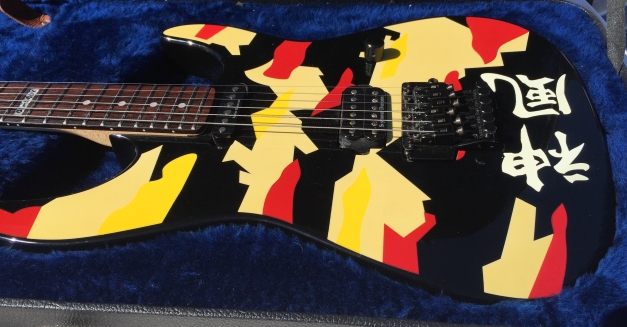
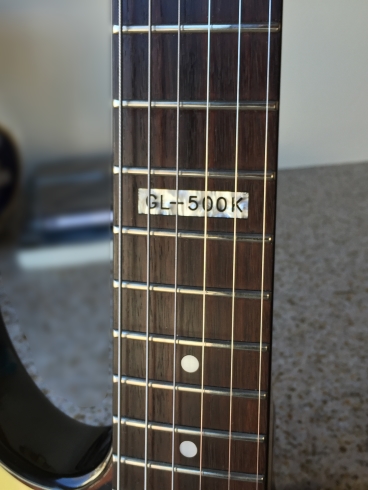
Blurb:
Classic George Lynch guitar without breaking the bank. These guitars have been discontinued in favor of the lower priced GL-200K. If you can find one in good condition, it is night and day better than the GL-200K.Sound :
If you are looking for the classic 80's sound, this guitar is it. It comes pretty close to George Lynch's sound from the classic Dokken days, and that's a VERY GOOD THING. The body is alder, which is known to give a brighter sound. The pickups in my guitar are not the stock "Duncan Designed" pickups, they were replaced with actual Seymour Duncan pickups, and they are fantastic. They maintain clarity when you roll them back for incredible clean tones also. At full volume, and some gain, you will definitely be able to get all those George Lynch screaming pinch harmonics flowing through the guitar.Action, Fit, & Finish :
The guitar was in mint condition. There was not a single scratch or ding on it. The guitar sports the classic George Lynch Kamikase design, the one without the photo of the Kamikase pilot. The Kamikase pilot photo was placed on the lower GL-200K model.When I first bought the guitar (USED), it was not set up properly. But as with all guitars I buy, I take the strings off and clean the guitar before doing a complete setup on the guitar. Like many guitars from that era, this guitar has the truss rod adjustment facing the body. You have to take the neck off the body to adjust it, then put the strings on again, check the action, and do it again (if necessesary) until it you get it right. Also, this is the first guitar that I have seen that has both the truss rod adjustment facing the body and also uses hex keys for the adjustment. In the many other guitars with the truss rod facing the body, every one of them was a phillips head.
The reverse headstock takes fome getting use to also. Since I have switched to Cobalt strings, I have NEVER broken a string......that is, until stringing this guitar. It wasn't the guitar, or the strings, it was me. I never look anymore to see what string I am tuning. I've been doing it for so long that it's second nature. Well, that second nature routine caused me to break, not one, but two G strings during the setup. I was trying to tune the D string and it wasn't tuning correctly, so I continued to turn and turn, until that wonderful sound that you just broke a string. I didn't break the D, I broke the G because I was turning the wrong peg. And just to prove what a creature of habit I am, I actually did the EXACT same thing a second time.
Once the guitar was cleaned, and the set up was completed, the guitar was amazing. The fret work was incredible. Other than a quick cleaning with #0000 steel wool, I didn't have to do anything to the frets. They were in perfect shape. Crowned perfectly, edges filed and rounded perfectly. The neck has a longer scale than most of my other guitars, and it is a very wide neck. It's not a thick neck, just wide. At first it took some getting used to, but soon I realized what a huge benefit it really was. The benefit is that you can play a wider vibrato without muting the strings next to it.
The jack is at the bottom of the guitar, like other super strats, but this one is offset, which points the cable out towards the back of the guitar.
The part of this guitar that takes a little time to get used to is the pickup selector. There is not switch to change pickups. There is only one knob on the entire guitar. It's a push-pull volume pot that doubles as a pickup selector. Pull the pot up for the single coil neck pickup and push it down for the humbucker. Like I said, it takes a little getting use to, but it seems very intuitive once you do get use to it. I also find myself using the volume pot more on this guitar than any of my other guitars. Roll it back for some incredible clean tones, and turn it up for that George Lynch Dokken crunch sound.
This guitar is a pleasure to play.
Customer Support :
Haven't needed any customer support.Liked about it :
The feel of this guitar is an excellent guitar, especially for the money. This thing screams. It's 80's "Hair Metal" all the way. But it also shows it's seofter side when rolling off the volume. After getting use to the push pull pickup selector, I find it very easy to have everything in one location. I wonder why all guitars with 2 (non-split) pickups don't use this configuration.Didn't like :
The only thing I didn't like about this guitar was the truss rod location. It's not a major deal once the guitar is set up, but is a real pain to do it the first time. Once it's done, more than likely you won't have to do it again.Rating:
My overall rating on this is a solid 8/10. Incredibly confortable guitar. Incredible sound. Just an incredible guitar. If you can find a 500 or 600 series, get it. You wont be disappointed. Not so sure about the 200 series.ESP LTD Lynch Sunburst Tiger GL-500T (8/10)

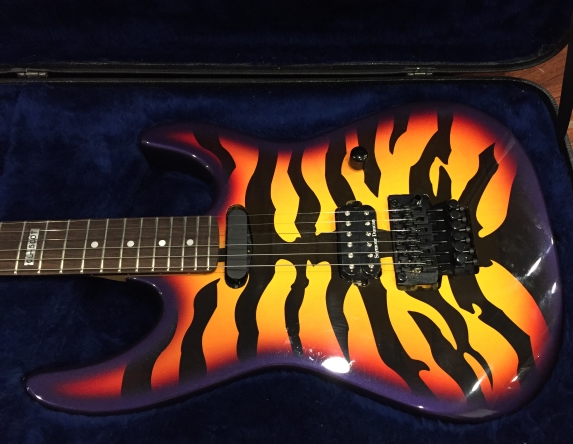
Blurb:
Classic George Lynch guitar without breaking the bank. These guitars have been discontinued in favor of the lower priced GL-200 series. If you can find one in good condition, it is night and day better than the GL-200SBT. The 200 series has a completely different neck joint (at the headstock), it's a lot bulkier than the 500 series. This guitar's neck joint is designed perfectly. It's very comfortable.Sound :
This guitar has a slightly different tone than the Kamikaze. It definitely has the classic Lynch sound, but it's different. As with the Kamikaze, I changed the humbucker to the Seymour Duncan JB/TB (TB-4). The Kamikaze is slightly brighter than this guitar.Action, Fit, & Finish :
The ESP LTD 500 and 600 series guitars are leaps and bounds better than the 200 series that they are currently selling.I bought this used. When I opened the case, I was stunned at how beautiful the guitar was. I've seen pictures of it, but seeing it in person is a whole other experience.
The guitar was in mint condition. There was just a little bit of belt rash on the back. The guitar sports the classic George Lynch Sunburst Tiger design.
As with all guitars I buy, I take the strings off and clean the guitar before doing a complete setup on the guitar. Like many guitars from that era, this guitar has the truss rod adjustment facing the body. You have to take the neck off the body to adjust it, then put the strings on again, check the action, and do it again (if necessesary) until it you get it right. I posted a tutorial on how I adjusted the neck in the Guitar Maint section of the website.
The guitar has the George Lynch reverse headstock, which adds to the guitar's beauty. I understand why they would want to have the truss rod access at the heal. This guitar is stunning. A truss rod cover would stand out too much.
The neck is fairly wide, but nowhere near as wide as the Lynch Kamikaze. It plays completely different from the Kamikaze.
The jack is at the bottom of the guitar, like other super strats, but this one is offset, which points the cable out towards the back of the guitar.
The pickup selector is a push/pull pot, like the Kamikaze. Pull the pot up for the single coil neck pickup and push it down for the humbucker.
This guitar is stunning to look at, and a pleasure to play.
Customer Support :
Haven't needed any customer support.Liked about it :
A stunning guitar, that stands out from any other guitar. It's beautiful. It's lighter than the Lynch Kamikaze. Plays like butter, and screams 80's metal.Didn't like :
Doing neck adjustments are more difficult when the truss rod access is at the heal. But, I fully understand why they do that.Rating:
My overall rating on this is a solid 9/10. Great sound. Just a great guitar. As far a playability, the Kamikaze is heavier, and has a slightly brighter sound.If you can find a 500 or 600 series, get it. You wont be disappointed.
Godin LGX-SA (Synth Access) (6/10)
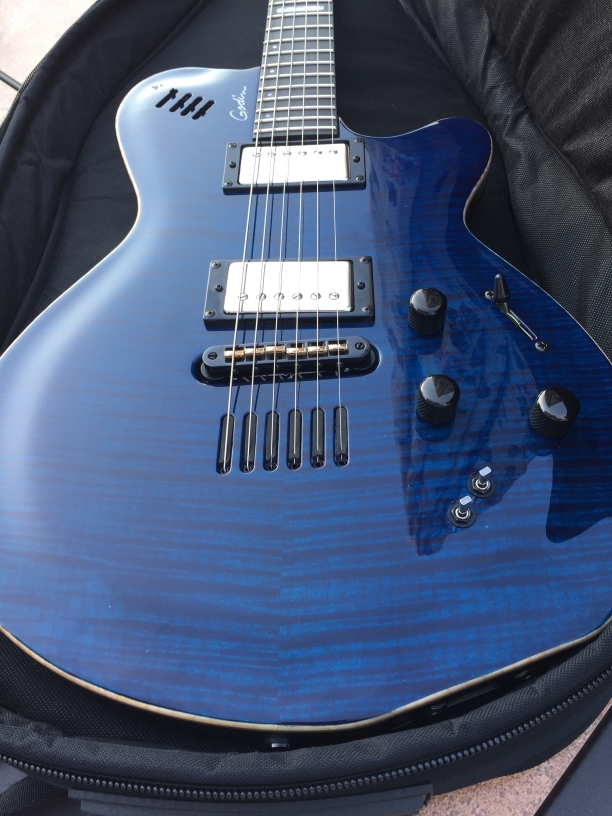
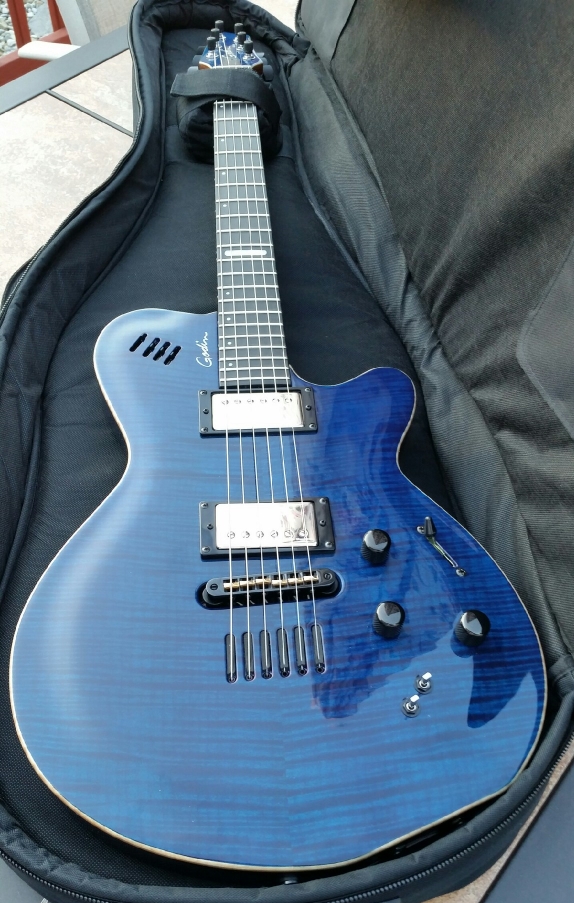
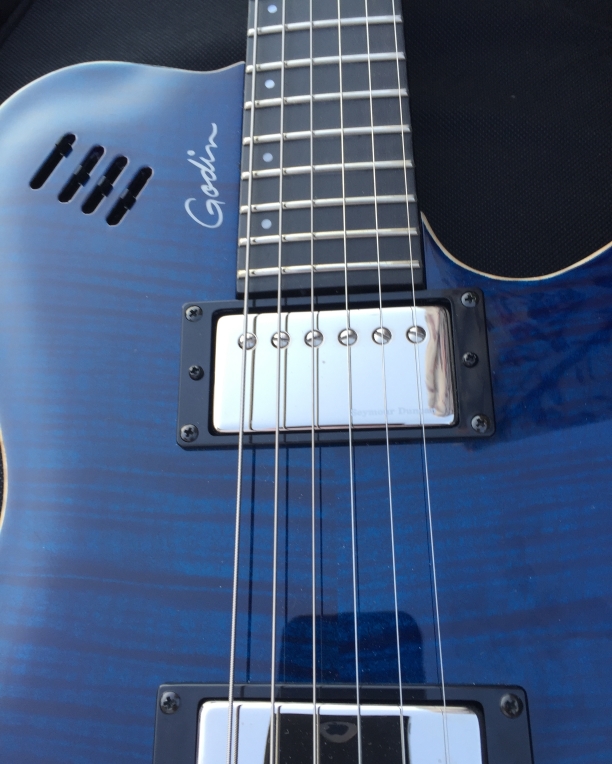
Blurb:
This guitar gives you the ability to play acoustic guitar, electric guitar and synth (which drives any Roland 13-pin processor). You can play any of the options separately, or any combination of the options with the controls on the guitar. The LGX-SA is a three-voice guitar featuring electric and acoustic guitar sounds, plus the infinite possibilities provided by synth access. The output from the bridge transducer system in the LGX-SA produces six separate signals—one for each string. This divided signal is called hexaphonic and is used to drive guitar synths. The LGX adapted itself to this application quite easily. However, in addition to the electronic modifications, the guitar itself was altered in order to achieve the best possible performance. The most visible difference between the standard LGX and the LGX-SA is in the ebony fingerboard. The use of the ebony fingerboard improves synth tracking. Guitar synth systems in the past were technically complicated and required radical changes in playing technique. The LGX-SA/RolandTM GR-synth combination represents a new standard in user friendliness and performance. This is truly a 'plug in and play' system. FEATURES:- Mahogany neck
- Ebony Fingerboard
- 16" fingerboard radius
- 25 1/2" Scale
- 1 11/16" nut width
- Mahogany body
- Figured Maple Top
- Seymour Duncan Custom Humbuckers
- 5-Way switch
- Guitar volume
- Tone
- Synth volume
- Program up/down
- 3-Way
- Magnetic Output
- 13-pin Synth Output
- Acoustic transducer Output
- RMC transducer saddles with custom Pre-Amp EQ for: Acoustic Volume, Treble, Mid-Range and Bass controls
Reliability & Durability :
It's a very well made guitar, which makes be believe that this guitar will play great for many, many years.Although I cannot talk about the longevity of the RMC pickups, there have been reports that they do not last forever, and are susseptable to sensitivity changes due to humidity.
Customer Support :
Haven't had any reason to call them.Liked about it :
This guitar plays absolutely beautifully. The contoured body is very comfortable. Very solid, but not too heavy. It is a joy to play. The Duncan pickups are a perfect set that sound great. The neck is along the lines of a skinnier Les Paul neck. The ability to play acoustic guitar with this guitar is an incredible option. To give you even more options, you have the synth access, which drives the Roland GR Guitar Synthesizers. You have a multitude of options at your fingertips with this guitar, and you can switch and blend each mode on the fly. Just an incredible versatile guitar. There are 2 switches on the guitar that control the GR unit. One switch is a 3 way toggle that allows for Synth Only, Mix, Guitar Only modes. The other toggle changes the banks on the GR unit. The piezo/acoustic sound is an incredible option. There is also a 3 band EQ for the piezo, so you can dial in your acoustic sound.Didn't like : My only gripe about the LGX-SA is the RMC pickups. They are very susseptable to humidity, which can play around with the sesitivity of the under-saddle pickups.
Eventually I ended up selling the guitar because the sensitivity change, even when the guitar not leaving my house.
I got tired of changing the settings on my GR unit on almost a daily basis.
I will never buy another guitar with RMC pickups. At least until the constant pickup sensitivity has been remedied.
Rating:
6/10 - This guitar looks absolutely stunning and gives you options that other guitars simply cannot give you. Only a 6/10 because of the RMC pickups. Otherwise, a solid 10.UPDATE:
After dealing with the RMC saddles changing sensitivity for about a year, I finally came to the conclusion that I had to sell the guitar. It is an incredible playing guitar. On a strickly guitar-only standpoint, the LGX is spectacular. But the weak link is the pickups changing sensitivity, seemingly at random. I used the guitar for recording, and it never left my house! Constantly having to calibrate the GR-55 when using this guitar simply became too much of a hassle for me. I struggled with the decision, but finally decided to let it go. If Godin moves away from the RMC pickups to a more stable solution, I'll be first on line to buy a new one.Kramer Baretta 84 (aka The '84) (9/10)
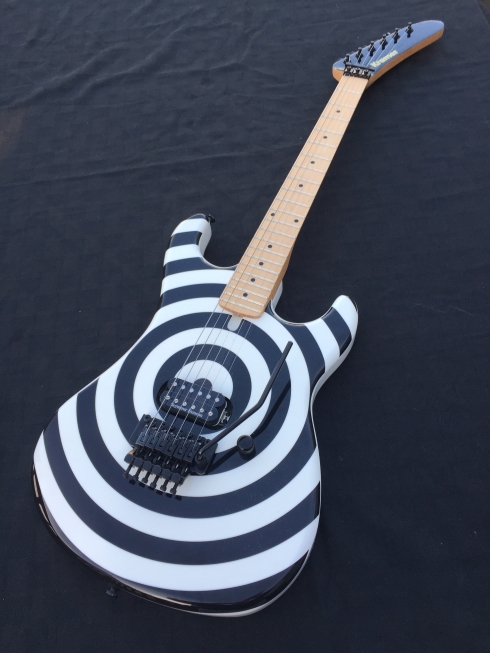
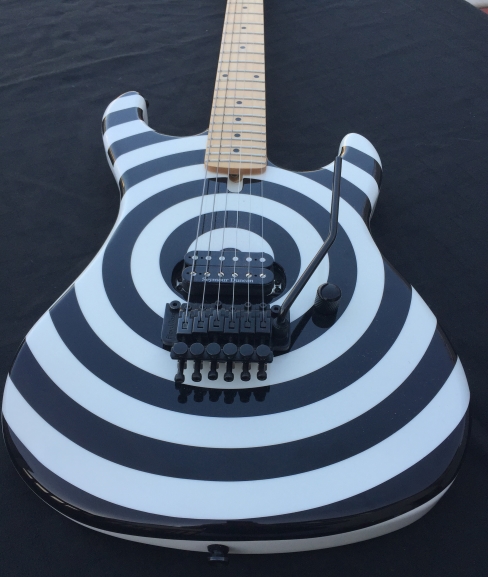
Blurb:
The '84 Long recognized as a leading manufacturer of high-performance rock weaponry, Kramer has put guitars in the hands of the world's top shredders for three decades. With a nod back to the golden age of high-octane rock guitar, Kramer introduces the 84, an homage to one of the most formative shred-monster axes of all time. Styled in the image of the original Kramer Baretta of 1984 with offset double-cutaway body and droopy "banana" headstock—the guitar played and endorsed for a time by Edward Van Halen—the ‘84 captures all the power, playability, and attitude of the original, with classic colors and graphics to make it more attention-grabbing than ever. Loaded with a single high-output Seymour Duncan® JB™ humbucker pickup in the bridge position with push/pull series parallel coil tapping and a Floyd Rose® "double-locking" vibrato unit, the ‘84 is finished in your choice of white, banana yellow, Diver Down,solid red, black with red bullseye, or white with black bullseye. Solid Maple body Maple neck with Maple fingerboard Sizzling Seymour Duncan open-coil JB pickup with push/pull coil tapping Original Floyd Rose tremolo with locking tuning system Premium die cast tuners with 14:1 tuning ratioReliability & Durability :
Customer Support :
Customer support was absolutely FANTASTIC!!!! I ordered this guitar from a dealer that wasn't near me, so it had to be shipped. When the guitar arrived, it was beautiful, with no signs of damage. After running it through all of my checks, I found that the first 2 frets were dead. No notes would ring out on the B and high E. I contacted the dealer, and he was willing to take the guitar back, but I wanted to see if the company would fix or even replace it because it recieved this way. I contacted them, and got an Return Merchandise Authorization within a couple of days. I shipped it, and verified that they recieved it. My only gripe about them was they weren't forthcoming with information regarding the status of my guitar. I called daily, and pretty much got the same answer that nothing was put in the system regarding the guitar. On about the 5th day, I got in contact with a great customer service representative that went above and beyond for me. She said that there was nothing in the system, and that this is unacceptable for a guitar to be here (there) this long without any updates. She escalated it to management, and got back to me that I should hear something in a day or two. She emailed me 2 days later to tell me that the guitar was completed, and was on it's way back to me. She was already prepared with the tracking number. I recieved the guitar 2 days later, and it was in PERFECT shape. Even the setup was amazing. This was the first guitar that I got where I didn't need to do a setup. I am very maticulous about my setups, adn it was absolutely to my specs.Liked about it :
The guitar was stunningly beautiful. I was a little concerned that a black and white bullseye guitar would look a little "dated". But when it arrived, it was really stunning. This guitar screams!!! It's has a great feel, nice weight, and perfectly balanced. It also has a coil split, via the single volume pot. You pull the pot up, and the guitar is in single coil mode. The guitar has great sustain, great feel, and sounds great. What's not to like? Since it is a reissue of the 1984 Kramer Baretta, the truss rod adjustment is on the heal of the neck (on the side of the body). The old way of adjusting the truss rod was to loosen the screws, tilt the neck away from the body, make the adjustment, tighten the neck, and repeatuntil satified. Thankfully, they added a routed out area to access the truss rod without any extra steps, which is a great thing. Didn't like : If I have to find any flaw with this guitar, it's a very minor, and insignificant one. The very thin sound of the single coil mode. It's a little bit too high end. But that's really a non-issue. The humbucker cleans up nicely when the volume is rolled back. I don't think I've used it in single coil mode, since originally testing it out.Rating:
I would probably give this guitar a 10 out of 10 if I didn't own the ESP Lynch (rated above). It's definitely my #2 guitar behind the Lynch. But, since I have the Lynch and the Lynch is ever-so-slightly better, I have to give this a 9/10. If I wanted to expand my rating system, I would give it a 9.5 out of 10. But, I'll stick to my system to avoid any confusion.UPDATE:
This guitar has become my "go to" guitar for over a year. It's just that good. I also rewired the volume pot to an out of phase signal. I no longer get that high end shrill that I got with the split coil. This guitar is beautiful, and an absolute joy to play. It just gets better.PRS SE 245 Black (8/10)/ PRS SE 245 Tobacco Sunburst (8/10)
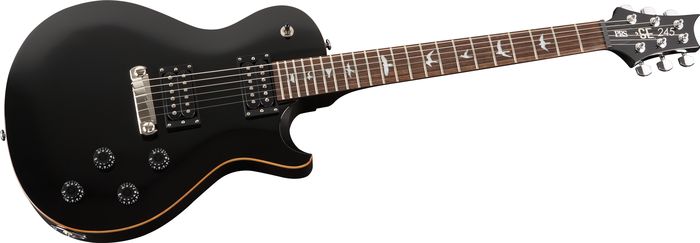

Blurb:
I bought 2 of these guitars. One was bought during some incredible price match a couple of years ago, and Musicians Friend price matched it from some other website. I first thought it would just be a deal because of the price and I would simply use it for songs that were usually played on Les Pauls. But that soon changed after it arrived. It is an incredible guitar, not just for the money, but in general. This guitar is well worth the full price, around $650. I bought the second one in a trade + cash deal at Guitar Center. It has a beautiful flamed maple veneer. These guitars are incredible. I'd buy another if I found a reason. If you have not checked out a PRS neck, they are simply incredible. I watched a documentary about their necks, and it said that they spend as much as 90% of their time on the necks. I can believe it. The neck is superb. Most of my guitars have a 25.5 scale length and are strung with 9s, the inch difference (24.5 scale length) makes a huge difference in feel. So much so, that I had to change this guitar to 10s to get the correct feel. The 9s felt like 8s on this guitar. Now with the 10s, it has the feel I'm used to.Sound :
The stock pickups sound very good. I like a clear sound on the high tones. I have played several Dimarzios (including Tone Zone, Chopper, etc.) and they always seem to be heavy bottom ended. The stock pickups are definitely more top heavy and brighter than any Dimarzio I have played. With that said, the guitar has a distinctly darker tone due to its 24.5" scale length. More like a Les Paul's balsy yet darker tone. Since it's essentially a Les Paul configuration, it's understandable.Action, Fit, & Finish :
The guitar is beautiful. The black one has a bound body, and the Tobacco has a beautiful flamed maple veneer finish. The body is Mahogany and the fretboard Rosewood. It has standard 2 humbucker configuration, 2 humbucker, 2 volume, 2 tone, 3-way switch. The neck is unbound and has bird inlays. Like an LP, these guitars are a little on the heavier side, yet very comfortable to play. Out of the box, the guitar setup was good, not great. A half hour later on each guitar, and they played like butter.Customer Support :
Haven't needed any customer support.Liked about it :
An incredible guitar. Very comfortable to play. Not as heavy as a Gibson Les Paul, but not as light as an Epiphone either. It has a nice dark tone to it. Not overly dark, but you can hear the difference that the scale length makes.Rating:
Either of the guitars rate a solid 8/10 - The Tobacco is beautiful, the black one is also beautiful. They both play exactly the same.PRS SE Angelus Alex Lifeson Acoustic (9/10)

Blurb:
Carrying over unique appointments from the Private Stock Alex Lifeson acoustic, the SE features a thinner body depth than PRS's standard Angelus model. A “Birds in Flight” inlay adorns the rosewood fretboard and pairs nicely with the unique back and sides crafted from figured Dao wood. Players will find a noticeably warm and resonate tone in the SE Alex Lifeson - even when amplified! An undersaddle pickup with both volume and tone knobs will give you all the control you need from the stage. With a solid spruce top, Dao sides and backReliability & Durability :
I've owned all my acoustic guitars for many years without issue. There is no reason to believe this guitar will be any different. In fact, the bracing is better than any other acoustic I own, so it might outlast me.Customer Support :
Haven't had any reason to call them.Liked about it :
My first concern was that most thin body acoustic guitars have a very thin sound. The thinner body, doesn't gie you the same tone as a full size, which is warmer. I loved the look of this guitar, with the offset bird inlays. But that's never a reason to buy a guitar. The sound and feel are the main reasons. When I picked up the guitar, I realize how well it was made. The feel was fantastic. When I started to play it, I was amazed at the tone. It has a great warm tone, which it incredible for a shallow body guitar.The neck is also different from most acoustic guitars. It almost has an electric guitar feel to it. Plugging it in, was a little bit of a disappointment. A piezo sounds the same in any guitar, a little thin. This takes away from the warmth of the guitar sound. The mic'd sound through a Shure SM58 sounded a little "tinny". The sound through a Blue Baby Bottle is just a little warmer than I'd like. The absolutely perfect solution was to record 2 tracks at the same time: The mic'd and the piezo. The set the levels of each track to my liking. It has worked perfectly. Didn't like : If I had to choose something that I wished that was a little better, it would be the piezo controls, which are located in the soundhole. There are 2 roll wheels, one for volume, and one for tone. Since the wheels are very thin, there is no room to place numbers on them. This is an incredibly small gripe, and has not diminished from the joy of playing and recording this guitar at all.
Rating:
This guitar is an easy 9 out of 10. The comfort of a thin body, with the warmth of a full size is an incredible feat. The guitar is a pleasure to play in every sense of the word. I guess the only upgrade would be a better fishman pickup, over the regular stock piezo, which sound like any piezo. Using the piezo with a Blue Baby Bottle gives you the best overall sound. A better pickup sound, and this guitar could have a perfect score.Ritchie Blackmore Stratocaster (1997 Japan version) (9/10)
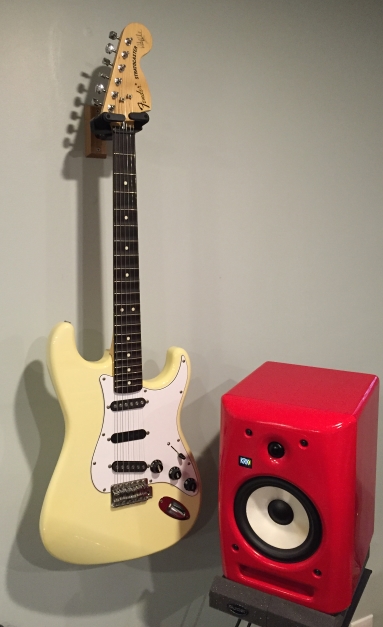
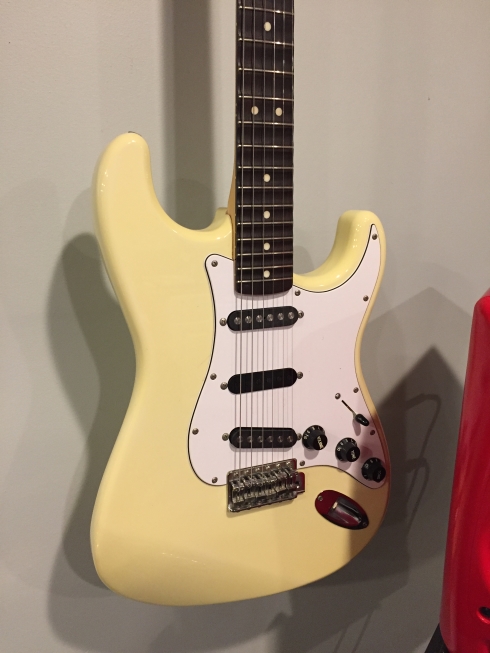
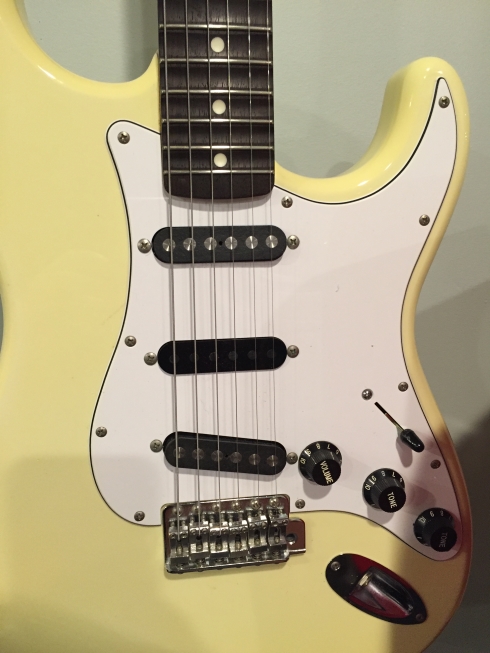

Blurb:
A signature model Stratocaster based on Ritchie's favorite Stratocaster.As a Blackmore fan, I have always looked at these as a "nice to have" guitar, not a "need." After finally buying one, it is an incredible Stratocaster.
As expected, I had to do a quick setup on this guitar. I never use the tremolo on any strat, so I moved the bridge flush with the body. That added an incredible amount of sustain to this guitar.
SPECS:
- Body: Basswood
- Neck: Maple, U-Shape, (Polyurethane Finish)
- Fingerboard: Rosewood, 7.25” Radius (184 mm)
- Graduated Scalloped
- No. of Frets: 21 Vintage Style
- Pickups: 2 x SSL-4 Seymour Duncan Quarter Pounders
- Controls:Master Volume,Tone 1. (Neck Pickup),Tone 2. (Bridge Pickup)
- Pickup Switching 3-Position Blade:
- Position 1. Bridge Pickup
- Position 2. Bridge and Neck Pickup
- Position 3. Neck Pickup
- N.B. Middle pickup is a dummy plate
- Bridge: Vintage Style Tremolo with steel block
- Machine Heads: Fender Vintage Tuners
- Hardware: Chrome
- Pickguard: 3-Ply Parchment
- Scale Length: 25.5” (648 mm)
- Width at Nut: 1.650” (42 mm)
- Unique Features: 3 bolt neckplate with "micro-tilt" adjustment
Sound :
The sound is simply incredible. It is, without a doubt, the closest I've ever heard to the true Blackmore sound.The guitar comes with a 3 way pickup switch. This is because the middle pickup is a "dummy" pickup. It's not a pickup at all, it's a piece of plastic that looks like a pickup. Ritchie never used a middle pickup. At first, this might seem a little strange, but as soon as you hear the sound generated from the 2 Duncan SL-4 pickups, you realize that there is no need for a middle pickup. The SL-4 pickups are much stronger than regular single coil pickups. They are more in line with P90s than single coils. The middle position gives a nice mix of the bridge and neck pickups.
Action, Fit, & Finish :
The finish is an Artic White (slightly more yellow than the Olympic white). The body of the guitar seems heavier than my other Strats. A small part of that extra weight is the tremolo block, which is larger than the standard tremolo block. This gives you added sustain. But, in reality, the added mass of the block isn't where the added weight comes from. This body is much heavier than other strats.Customer Support :
Haven't needed any customer support.Liked about it :
The feel of this guitar is exceptional. Hands down the best Stratocaster I own. The scalloped neck is a pleasure to play. The added mass of the tremolo block makes a difference in this guitar.Didn't like :
The only thing I can say I don't like is the small radius fretboard (7.25" radius). This is the standard for Vintage Fender necks. As with all small radius fretboards, there is a tendency for the high E and B strings to "fret out" when bent beyond the mid point of the neck. But, I guess it doesn't bother Ritchie, so I'll have to work with it.Rating:
The guitar itself, without the RMC pickups was a 9/10 if not 10/10. The RMCs bring my overall rating on this to a 6/10.Schecter Hellraiser C-1 FR-S (10/10)
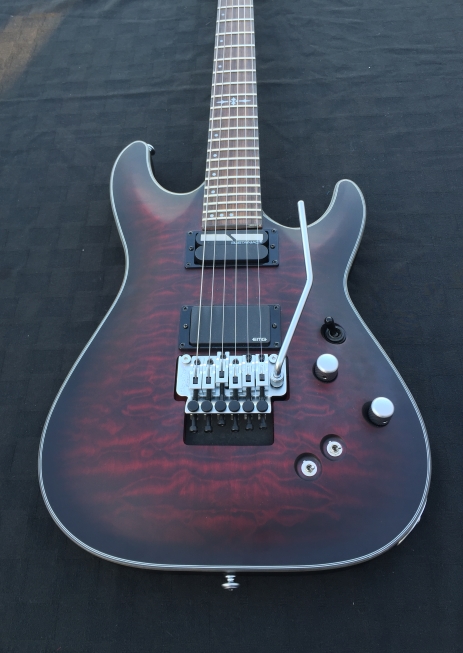
Blurb:
Schecter Hellraiser C-1 FR-S Solidbody Electric Guitar at a Glance:- Rock-solid construction with high-end appointments
- Sustainiac humbucker gives you never-ending tone
- Floyd Rose 1000 Series bridge/tailpiece lets you carve out hardcore bends
Rock-solid construction with high-end appointments When you pick up a Schecter Hellraiser C-1 FR-S guitar, you'll be amazed by all of the details and finishing touches that make this a truly remarkable instrument. Its beautiful quilt maple top appears to leap off the surface, and the intricate inlays in its bound fretboard add a special touch of class. What's more, these details aren't just cosmetic. The Hellraiser C-1 FR-S features a set neck with an Ultra Access heel carve, which gives you easy access to those higher, hard-to-reach frets.
Sustainiac humbucker gives you never-ending tone You just can't beat the sheer sustain you'll get out of your Schecter Hellraiser C-1 FR-S's Sustainiac humbucking neck pickup... literally! That's because this unique pickup design features a special sustain circuit that's designed to let notes ring on as long as you like. Just kick in the sustain circuit, play a note or chord on your Hellraiser C-1 FR-S, and let the electromagnetic feedback carry your sound as long as you like. You haven't busted out a solo till you've rocked a Hellraiser C-1 FR-S!
Floyd Rose 1000 Series bridge/tailpiece lets you carve out hardcore bends Schecter knows that serious shredders like you demand absolute performance out of their guitars. That's why they loaded the Hellraiser C-1 FR-S with a real Floyd Rose 1000 Series tremolo bridge. A remake of the original Floyd Rose blade tremolo, this incredible bridge lets you grab on, rock out, and never worry about pulling your action out of whack. You'll get both the rock-solid reliability and the tight response you need when you rock out with a Schecter Hellraiser C-1 FR-S!
Schecter Hellraiser C-1 FR-S Solidbody Electric Guitar Features:
- Full-featured solidbody electric guitar made for modern playing styles
- Slim body style and thin neck provide you with fast action and a comfortable feel
- Beautiful quilt maple top adds spank to a rich mahogany body and responsive 3-piece mahogany neck
- Sustainiac neck pickup delivers limitless sustain and wicked lead tone
- Set neck with Ultra Access heel carve gives you easy access to your upper frets
- Floyd Rose 1000 Series Tremolo bridge gives you easy flexibility and reliable stability
- Neck-though-body design adds impressive sustain to your tone
Reliability & Durability :
The guitar is built like a tank. Not worried about it not holding up.Customer Support :
Haven't had any reason to call them.Liked about it :
When I first played the guitar, I noticed that the feel was very comfortable, and easy to play. The contoured body adds to this comfort. The neck has a 14" radius, which is very flat, with jumbo frets. The heal of the neck quite possibly could be the best heal I have ever had. The pickups are active EMGs. I've never played them before and they take some getting use to. Very hot, very bright. These pickups may be the first pickups that made me use the tone knob...ever. The neck-through-body gives you quite a lot of sustain, even without the sustainiac activated.After just playing the guitar in it's normal state, it quickly felt like a perfect fit. The heal of the neck quite possibly could be the best heal I have ever played.
Then I started playing around with the sustainiac, and it really blew me away. It turned a great guitar into one that is almost too much fun to play. There are 2 switches, on/off and a 3-way mode select toggle, normal/mix/harmonic mode. Just using the normal mode, you can sustain a note indefinitely (until the battery dies). Gone are the days of getting to the gig early and walking around the stage, trying to find the spots where your guitar will feedback and sustain a note for a long time. It will do that anywhere, at any volume.
Didn't like : I've read that Schecter guitars are known for the setups on their guitars out of the factory. I was unimpressed. The action was much higher than expected. I already knew I was doing a setup on it, since it comes with 10s and I play 9s, so the original setup didn't matter at all. But after reading so much about their setups, I was disappointed in the factory setup.
Rating:
10/10 - Without the sustainiac, this guitar would be a solid 9/10. With the sustainiac, it's a guitar that will give you options that other guitars cannot. It's almost too much fun to play. It's like cheating.Amps / Effects Processors
Mesa 4X12 Traditional Cabinet (9/10)
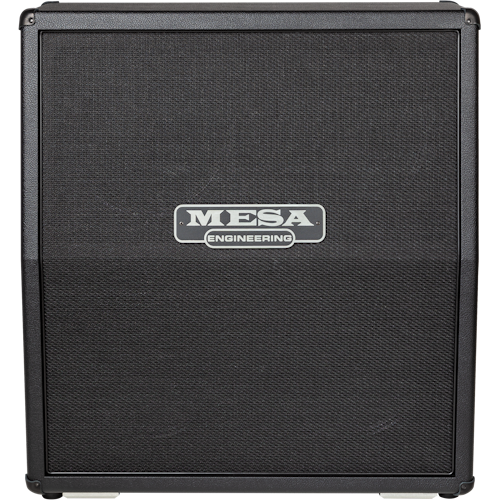
Blurb:
Mesa Rectifier Traditional 4x12 Cabinets are considered the best cabinets ever made. They come in different speaker configurations, but the Celestion Vintage 30s are considered a great match for the cabinet. The cabinet produces a tighter and more focused low-end response, though still delivering massive 4x12 punch and authority. The Mesa cabinets from the early 2000s are considered the "grail era" cabinets, due to the way that the V30s were voiced during that period.Reliability & Durability :
This cabinet is built like a tank, and has been proven to last through many tours, and coming out perfectly fine.Customer Support :
Not needed.Liked about it :
Possibly the best sounding cabinet I have ever played through.Didn't like :
If I had to make a choice, it's a very heavy cabinet. Thankfully, it comes with very well made casters that allow you to push it, rather than carry it.Rating:
Easily a 9/10. Fantastic cabinet. If you can find a "grail era", grab it. It's well worth the price.Genz Benz G-Flex 2x12 (7/10)
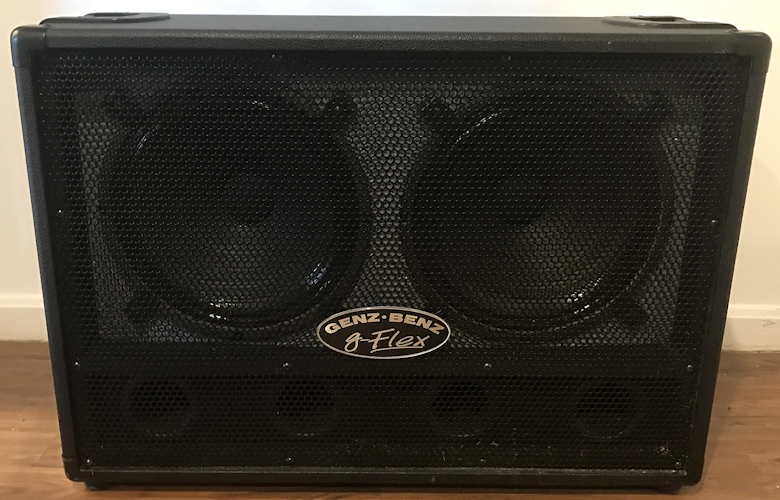
Blurb:
This dynamic 2 x 12" ported guitar cabinet is designed for monster tone and performance. This unique design features multiple ports and a flexed baffle. The porting produces a punchy low-end crunch, while the FLEXED baffle reduces the boomy interior standing waves and increases the projection of the GBE 1240-V75 speakers. The result is a huge sounding 2 x 12" cabinet with rich, distinctive tone, which can out-perform many 4 x 12's. Wired for mono or stereo operation.Reliability & Durability :
Built like a tank. Can easily handle touring and be absolutely fine.Liked about it :
The ported cabinet gives this 2X12 cabinet the low end that is missing from some 2X12 cabinets. I usually mic the speaker, and also one of the ports for the low end.Didn't like :
I wasn't a big fan of the stock speakers. Changing the speakers to Celestion Vintage 30s really brought this cabinet to the next level.Rating:
Due to the stock speakers, the rating is a 7 out of 10. With the V30s, the cabinet is a 8/10. If it had casters, it would be easier to move.Crate Blue Voodoo BV412ST cabinet (8/10)
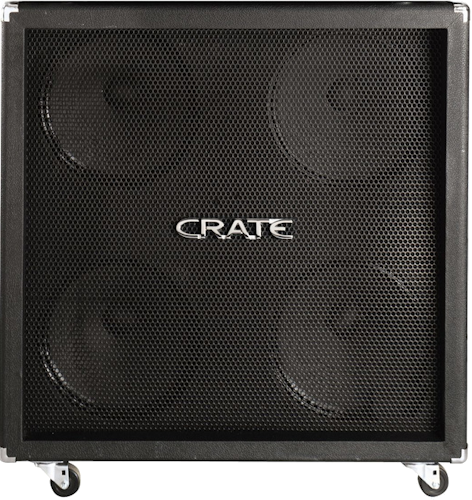
Blurb:
A 75 lb, 200 watt, slant front cabinet loaded with 4 x 12 in. Eminence speakers model 86-078-16 wired for stereo/mono operation. Each enclosure is port tuned and features 3/4 in. quality checked, void-free Birch wood, a protective metal grill, and fixed casters for easy transportation. Made for professional musicians, these enclosures are perfect for serious music enthusiasts.Reliability & Durability :
This cabinet actually rivals the Mesa in build quality. It is very well made, and will definitely withstand the road.Liked about it :
I was pleasantly surprised when I first bought this cabinet. The stock speakers are very good. I haven't changed them. The Eminence 86-078-16 speakers actually rival the sound of my Celestion LynchBacks. Yes, they're that good.Didn't like :
Once again, there isn't much not to like. It's a heavy Birch cabinet, like the Mesa. It's 75 lbs.Rating:
This cabinet gets an 8/10. It rivals the Mesa cabinet, and can be bought at less than half the price of a Mesa, especially used.HeadRush FRFR-112 2000 Watt powered cabinet(7/10)
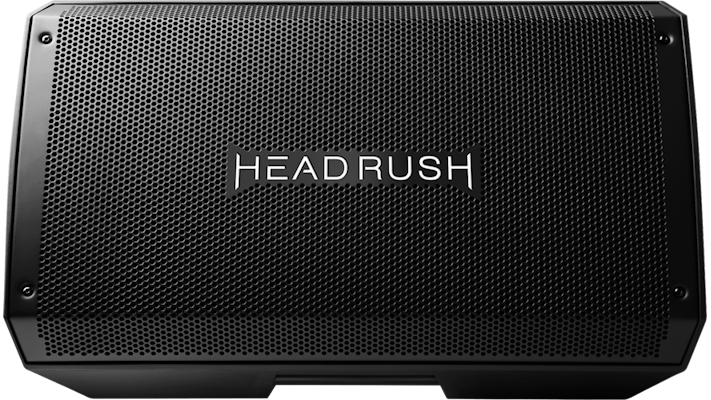
Blurb:
The HeadRush FRFR-112 is a lightweight 2000-watt full-range, flat-response (FRFR) powered cabinet that gives you a realistic room-filling sound with the authentic feel of a speaker pushing air. Specially-voiced 12-inch woofer and high-frequency compression driver. 2000 watts of peak power (2) XLR/TRS 1/4-inch combo inputs Independent volume controls and clip indicator per input Contour EQ switch Ground-Lift switch XLR output for FOH or additional FRFR-112 cabsReliability & Durability :
This is basically an FRFR cabinet that is built out of plastic. It's not like a guitar speaker cabinet. It's well built, but it's plastic. So, who knows how it will handle the road.Liked about it :
Fantastic sound at a great price. Would work perfectly fine with any guitar modeler or a multitude of other devices. 2 XLR/TRS connections allow you to connect multiple devices at the same time.Didn't like :
The one thing that many people have complained about with this speaker is that it has a pronounced low end. There is a contour switch on the back that adds low end, which sounds great at lower volumes. When I turned the contour off, I didn't notice a pronounced low end. Sounded fine to me.Rating:
Overall, this gets a 7 out of 10. A very good FRFR at a great price.Randall RM100KH Kirk Hammett 100w head (9/10)
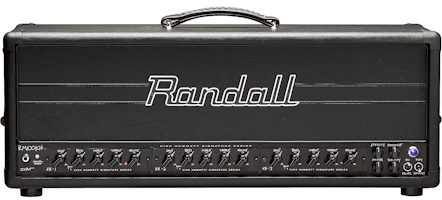
Blurb:
The Randall MTS Series RM100KH amp head was developed with one of the world's most influential guitar players to produce each all-tube tone of Kirk's illustrious career. This all-tube 100W Randall amp head includes three modular tube preamps including the KH1, Kirk's signature clean, the KH2, Kirk's classic rhythm tone, and the KH3, Kirk's modern lead and rhythm tone. Based on the revolutionary MTS design, this guitar tube amp head includes 3 fully modular channels that can also be changed or reconfigured to hold any of Randall's MTS tube preamp modules. The RM100KH is a modified Randall RM100 modular 100W amplifier. It is a 3 channel amplifier that take modular preamps for the Randall MTS as well as Synergy systems. With the modular system, you can have your sound, your way. Want an amp with a Plexi sound, a Mesa sound, and a Vox sound? This amp can give it to you. Just get the modules you want, and the amp powers them.Reliability & Durability :
I've had several RM100 amplifiers, and they are built to last. I've never had a problem with them.Liked about it :
A fantastic amplifier, where you can change the sound of the entire amp by replacing one of the 3 modules.Didn't like :
The amp weighs a ton. Make sure you're lifting weights to prepare to move this amp from gig to gig. If you're leaving it in the studio, you're fine.Rating:
A solid 9 out of 10. The modular design works incredibly well. It has been my mainstay amplifier for years.Fryette Power Station 2 (10/10)

Blurb:
This is like a Swiss Army Knife of power amps. It's a tube power amp, and a Line Out box, and an attenuator, an ohm converter from your amp's output to the output of your speaker, an added effects loop, and a power booster for low powered amps. Unlike other attenuators, the PS2 perfectly preserves the tone of the attenuated amplifier at any volume setting down to whisper level. Allows you to extend the voicing of any amplifier - a vintage amp can sound more modern, a modern amp more vintage, a dull sounding amp more alive, and a "spongy" amp can sound tighter, etc. This is an amazing attenuator that is a must for anyone who wants the power tube saturation of a cranked amplifier, but doesn't want the neighbors calling the police on you.Reliability & Durability :
I've have mine for several years, and never had a problem with it. This thing has some weight to it.Customer Support :
No need for CS.Liked about it :
Didn't like :
There isn't much not to like about the PS2. It is an amazing piece of gear.Rating: (10/10)
At first, you may be put off by the price, but you will probably use all of it's functions at one time or another. This is a must have for anyone with a high powered amplifier that doesn't have a master volume, or someone who wants that power tube saturation at bedroom levels.ADA-MP1 preamp (7/10)

Blurb:
There's no question that the ADA MP-1 is an iconic piece of gear. I'm not entirely sure if it's the ability to create ridiculously saturated distortion, or to program 128 settings and instantly recall them, or the aesthetics of the blue vinyl, membran buttons contrasted with the large red LCD screen. Regardless, the MP-1 was, and still is, an amazing preamp and the tones it creates still hold up today. Nostalgia: These units were released in 1987 which was about five years before I started playing the guitar the guitar in 6th grade. This was the first piece of gear that combined an all analoge tube preamp with digital controls and programmable midi switching. Previously, midi was only popular with keyboardist and computers, and ADA really got a lot right with this unit and it became a must have preamp of the late 80s and early 90s.Reliability & Durability :
This is a piece of gear from the 1980s, and it is a 1U rack size. I suggest putting it in a rack case as soon as possible to protect it. IF you're gigging with it, I suggest a shock proof rack case.Customer Support :
The company customer service is long gone for this unit. But, thankfully, there is a website full of ADA-MP1 enthusiasts who will help you with any issues you have. https://adadepot.com/Liked about it :
This is the exact piece of gear that dominated the 80s and 90s rock albums. It was used on many albums during that period. If you want that 80s sound, but don't like modelers, this is the perfect piece of gear for you.Didn't like :
The battery is soldered to the board inside the unit. If the battery dies, you either have to de-solder the battery and re-solder the battery, or perform the battery mod, where you solder a 2032 battery holder to the board. At that point, you can simply replace the battery in the battery holder, like you would in any other device.Rating:
I gave it a 7/10. If you want that 80's sound, this is a must piece of gear. If not, you might want to look elsewhere. The battery mod is a MUST when you get one.Synergy SYN-1 preamp (9/10)
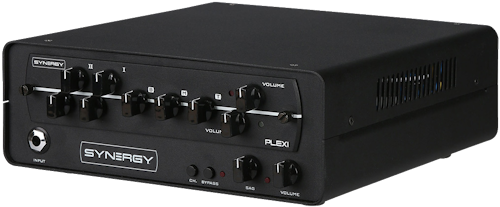
Blurb:
Unlock the full potential of your Synergy preamp modules with the convenient and powerful SYN-1 Single Module Tube Preamp. The SYN-1 is a roadworthy, professional housing that is compatible with any of Synergy's interchangeable preamp modules. Want to change your sound? Simply slide in a different Synergy preamp module and you can access a whole new array of boutique amp tones. The SYN-1 provides a powerful, flexible gateway to boutique tone in several different ways. Using the SYN-1 loaded with a Synergy module you can: Go direct out (XLR or ¼”) into a recording console, concert venue mixer or powered monitor Add two new “boutique” channels to your current amp via the series effects loopReliability & Durability :
The SYN-1 is built extremely well, and has been a mainstay in my current studio.Liked about it :
The SYN-1 and SYN-2 allow you to make your amp into a boutique amplifier by hooking it up into your current amp. It gives you amp 2 extra channels as well as maintaining the effects loop. There is also an XLR out for Direct recording. There is an option to use an internal V30 IR, so you can do silent recording through the SYN-1 as a standalone unit. The Synergy system builds upon the Randall MTS Modular preamp system, so it also handles all the Randall MTS modules also.Didn't like :
Not much not to like.Rating:
9/10. The Synergy system is the next step in the Randall MTS modular game. Synergy moves it a step forward by licensing the companies to give you the actual preamps of their amps.Synergy SYN-2 preamp (9/10)

Blurb:
This is the big brother to the SYN-1. It handles 2 modules, whereas the SYN-1 handles 1 module. Unlock the full potential of your Synergy preamp modules with the powerful SYN-2 Dual Module Tube Preamp. The SYN-2 unleashes your boutique tube tone in three extremely useful ways. The cabinet-simulated direct output sends your 12AX7-driven tone direct to your recording console with the exact sound and feel of a high-end tube amp. Thanks to its ability to replace an amp's onboard preamp and convenient rack-mounted design, harnessing fantastic tone onstage and on the road has never been easier. And for those of you who want to add a dose of flexibility to your current rig, the SYN-2 will integrate with your amplifier and effects, adding four more footswitchable channels to any amp with a series effects loop. Whether at home, in the studio, or onstage, rely on your Synergy SYN-2 Dual Module Preamp for harmonically rich tube tone.Reliability & Durability :
The SYN-2 is built extremely well, and is a 1U rack unit. It can be placed in your rack unit.Liked about it :
The SYN-1 and SYN-2 allow you to make your amp into a boutique amplifier by hooking it up into your current amp. It gives you amp 2 extra channels as well as maintaining the effects loop. There is also an XLR out for Direct recording. There is an option to use an internal V30 IR, so you can do silent recording through the SYN-1 as a standalone unit. The Synergy system builds upon the Randall MTS Modular preamp system, so it also handles all the Randall MTS modules also.Didn't like :
Not much not to like.Rating:
9/10. The Synergy system is the next step in the Randall MTS modular game. Synergy moves it a step forward by licensing the companies to give you the actual preamps of their amps.Avid Eleven Rack (6/10)

Blurb:
For its time, this unit is stellar. It's downside would be the lack of Impulse Response capability. If you pair this with an IR pedal, it will hold up to the current day. Get the ultra-realistic sound and feel of playing through dozens of the world's greatest guitar and bass rigs-without the expense or hassle. Capture performances using the same professional audio recording software used to create your favorite albums. Then take your tones from the studio to the stage, using Eleven Rack as your standalone amp modeler and signal processor. No matter how you use it, you'll always have the right tone at your fingertips when you need it. Stop struggling with trying to get the sound you're after. With Pro Tools + Eleven Rack, you get great tone and versatility, and a tightly integrated, fully tricked-out hardware/software audio recording solution that keeps up with your creativity. Have access to dozens of the most coveted rigs and stompbox effects for a fraction of the price of a single vintage amp.Features
- Pro Tools software
- Compose, record, edit, and mix using industry-standard tools
- Build big productions with up to 96 simultaneous stereo audio tracks
- Create and edit rig settings right from within Pro Tools
- Record dry and processed signals simultaneously for easy re-amping
- Never worry about saving presets, as all rig settings are embedded into recorded tracks
- Polish mixes with 70 sound processing, effects, and utility plug-ins included
- Compose music with the included virtual instruments and MIDI and notation tools
- Work with coveted pro features”Automatic Delay Compensation, multitrack Beat Detective, DigiBase Pro, and more
- Adjust pitch and time on the fly with Elastic Pitch and Elastic Time
- Collaborate with others easily with built-in OMF/AAF/MXF file interchange
- Use Pro Tools software with Eleven Rack or standalone
- Eleven Rack hardware
- Get incredible emulations of classic amp tones inspired by Fender, VOX, Marshall, Soldano, and Mesa/Boogie
- Enhance your tone with classic stompbox effects inspired by MXR, Electro-Harmonix, Ibanez, Pro Co, Univox, and more
- Gain realistic response and tone with the unique True-Z impedance-matching guitar input
- Customize your sound with convolution-based cabinet and microphone emulations
- Get the performance you need through powerful onboard DSP acceleration
- Record up to eight simultaneous channels of 24-bit/96 kHz audio”with near-zero latency
- Stay in tune with the built-in guitar tuner
- Customize time-based effects through tap-tempo control
- Have the connections you need to rig up your gear for recording:
- One XLR mic input with 48V phantom power
- Two 1/4" line-level inputs
- Balanced stereo XLR outputs and dedicated 1/4" outputs (for amp connection)
- Two 1/4" FX sends and returns
- AES/EBU and S/PDIF digital I/O
- 1x1 MIDI I/O
- Stereo 1/4" headphone jack
- Pedal/footswitch input
- Get high-speed USB 2.0 connectivity with your Mac or PC
- Take your sound from the studio to the stage with full standalone functionality
- Eleven Rack Expansion Pack
- Expand your tonal versatility with guitar amp tones inspired by Bogner, Celestion, Fender, Marshall, Matchless, Roland, and more
- Re-create the legendary thunderous bass tones inspired by the Ampeg SVT
- Enhance vocal and mic'd instrument performances with studio-grade processing and tools
- Add life to your tone with dynamic stereo delay, multi-chorus, and other effects
- Bring more authenticity and character to your rig with full speaker breakup emulation
Supported sample rates: 44.1, 48, 88.2 and 96 kHz
Analog input:
- 1 x 1/4" TS True-Z
- 2 x 1/4" TRS Line
- 2 x 1/4" TRS FX Loop Return
Analog output:
- 2 x XLR Main
- 2 x 1/4" TRS FX Loop Send
- 2 x 1/4" TS Output to Amp
Digital input:
- 1 x XLR AES/EBU
- 1 x RCA coaxial S/PDIF
Digital output:
- 1 x XLR AES/EBU
- 1 x RCA coaxial S/PDIF
MIDI I/O:
- 2 x 5-pin, DIN MIDI In, MIDI Out/Thru
Sync I/O:
- AES/EBU
- S/PDIF
Headphone output: 1 x 1/4" TRS
Dimensions (W x D x H): 19" x 13.5" x 3.5" (483 mm x 343 mm x 89 mm)
Reliability & Durability :
This thing is a rack unit, steel construction, and can be stored in a rack or standalong on a desk. It's built like a tank, and should be working long after you stop playing guitar.Customer Support :
Haven't had any reason to call them.Liked about it :
First, I like the name's reference to Spinal Tap: This one goes to eleven. I have been able to dial in any sound I have been looking for (after the learning curve). The Eleven Rack acts just like an amplifier, turn down the volume on your guitar, and the sounds cleans up, exactly like an amplifier. The Eleven Rack comes with a multitude of Amps, Cabinets, Microphone and Effects to give you so many options on creating the exact sound you are looking for. As an example of the versatility of the Eleven Rack, you even have the options ofspeaker breakup and even if the mic is on axis or off axis. These settings can be dialed in on the Eleven Rack itself, but you can use the Eleven Rack Patch Editor that works on your computer (with the Eleven Rack plugged in via USB) and create your patches in a simple layout. You can hear how the patch will sound before saving it to the Eleven Rack, so you can tinker away for hours and easily find your sound. And if that wasn't enough, there is also an effects loop (just like an amp), where you can add your own effects to the sound. Just turn on the effects loop option, and you are on your way.Didn't like : As with any multieffects processor, when beginning, it can be daunting and very frustrating. Since I've been down this road before with other multieffects processors, I fully expected to be completely lost for a while. Given the depth of this machine, I was lost for longer than expected. But I knew that the true enjoyment would come after getting a working understanding of the unit. I managed to get "over the hump" by tweaking the standard patches a little bit. I would try to change one or two settings for a while, until I was comfortable. I would then add another couple of settings, and eventually I was able to overcome the learning curve.
Rating:
A solid 7/10. This unit gives you the ability to tweak your sound over and over until you find your exact sound. Save that patch and move onto another. Eventually, you will have a large library of patches for any genre of music you play. A great unit that would have scored higher, if it wasn't for its age starting to show.Kemper Profiler (10/10)

Blurb:
For years, I didn't believe the hype about the Kemper. It was also a pretty expensive piece of equipment, so I always found other choices for my rig.That was a huge mistake. After finally breaking down and buying one, I realized that it would have saved me a ton of money. No longer needing to buy an amp, because your old amp doesn't seem to do it for you any longer. I don't believe I have every been happier with a piece of gear. This thing is spectacular.
There was a video from Andertons on YouTube where they gave a blind test to the Kemper vs Amplifiers. The results was amazing. The Kemper completely fooled them into thinking they were the real amps. That really got to my curiosity. I had to have one.
I had several amps over the years, and then something would bother me about them. So, I'd sell it, and get a new one. My last amp was a Roland LynchBox, which I loved. I bought the Kemper, to have all the other amps, and to see if the hype was real.
The Kemper acts exactly like a real amp. Every nuance of it. It's really amazing.
I soon decided to test the waters and Profile my LynchBox. Although I loved the Kemper, I still couldn't believe it could profile amps as well as anyone says. So, I wanted to test it for myself. I used my Shure SM57 mic, and mic'd my cabinet. Kicked up the Profiler, and let it do it's thing.
To my amazement, it lived up to all the hype. The results were spectacular. For weeks after, I had friends come over to see the profiler in action, and have them do the profiling for themselves. Every single one of them was floored by the profiling process. Even though they did the profiling themselves, they couldn't believe it was that easy.
Over the next few months, I profiled my amp over 80 times. Every possible setting, mic location, on every speaker in the 4x12. I soon realized that I was no longer playing my amp. I was playing the Kemper exclusively. It is actually that good. It made me not use my Amp.
I cannot say enough about the Kemper, and the Kemper community. There are tons of free profiles on the Kemper site. Some are great, and some not-so-much. But those profiles were probably due to lower level mics or gear during the profiling process. Profiling is easy, as long as it's done right. Like anything else, get your levels set correctly, and you'll get great results.
The profiling of amps is a game changer. You can get profiles for almost every amp, as soon as they come out. With modelers, you are beholden to programmers to program that specific model of amp you're looking for. Once that modeler is no longer their main model, they stop making new models for it. Thus, rendering it obsolete. With the Kemper, any amp can be profiled, so it's basically FUTURE-PROOF. Just an all-around amazing piece of gear.
There are 4 versions of the Kemper: Rack or Head ; Powered or UnPowered. The workings for the Rack and head are the same. They do exactly the same thing. Each has a powered and unpowered version. The powered has a 600 watt class D power amp inside.
I bought the unpowered rack, and use either a powered FRFR, or my Seymour Duncan PowerStage 170 (see review on this page) to power a cabinet. I couldn't be happier with either method.
Reliability & Durability :
So far, not a single problem. Most problems people have with the Kemper stem from installing BETA firmware. I wait for the final versions, and have never had a problem.Customer Support :
Haven't had any reason to call them (probably because I stay away from BETA firmware :) )Liked about it :
EVERYTHING!!!! This thing is the most amazing gear I have ever bought. I can't imagine being without one going forward. Some people complain about there not being an editor, like some modelers, but it's really not needed with the Kemper. It's very intuitive.Didn't like : I have not found anything that I can complain about the Kemper. This is my first "must have" piece of gear, ever.
Rating:
10/10 - An incredible piece of gear that is basically future-proof.Quilter Microblock 45 (6/10)
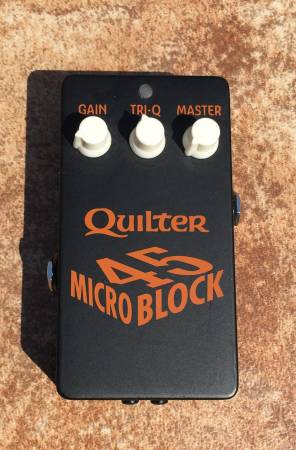
Blurb:
The Quilter Microblock is a very compact power amp that delivers 45 watts of power to use with any modeler or effects processor.It's about the size of a deck of cards.
Very simple design. 3 Knobs: Gain / Tri-Q / Master. Master is the master volume, but doesn't work with the gain knob at 0. The gain knob adds gain to the signal. The Tri-Q is a knob that spans between 3 EQ settings. At 0, it's a scooped EQ. At 50%, it's a rhythm EQ, and at 100% it's a bright lead EQ. The knob pans between any 2 of these to give you a bunch of tonal options.
You can use the gain knob as an overdrive to get some nice dirty sounds out of the pedal.
It's also built really well, but the knobs seem to be the weak link, if you put it on your pedal board and accidently step on it. There is also a headphone out at the back side of the pedal, near the power supply input.
Reliability & Durability :
This thing is built really well, but I would recommend placing something over the knobs to protect them.Customer Support :
Haven't had any reason to call them.Liked about it :
This power amp has plenty of power for a small gig, and maybe even more. I powered my 4X12 with it, and it got over 100 decibels.Didn't like : The fact that you need to use the gain knob to get to the upper volumes. It's not a pure clean power amp, but a great unit for what it does.
Rating:
6/10 - A nice backup poweramp.Roland GR-55 Guitar Synthsizer (9/10)
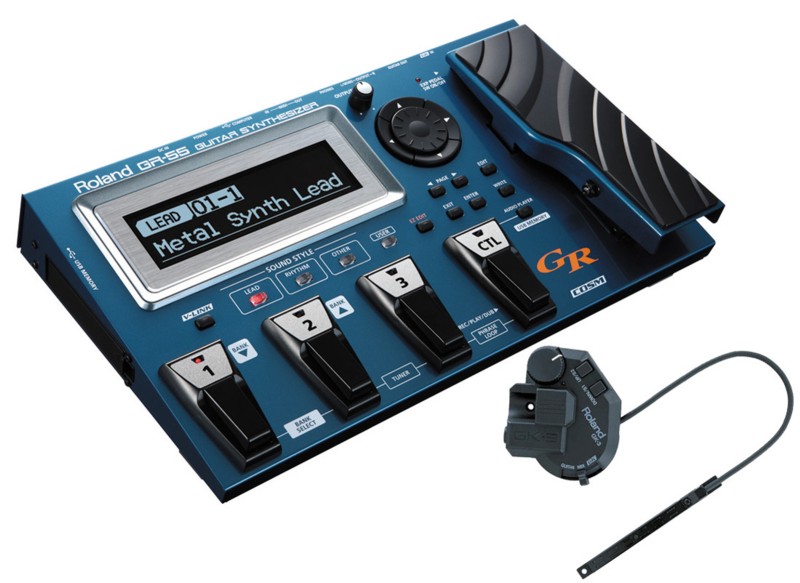

Blurb:
With the GR-55 (and a 13-pin connection from your guitar) you can play almost any intrument imaginable, simply by playing your guitar. Want to play piano, pick a piano patch. Want to play a sax, pick a sax patch. It's really that simple. This unit gives you all the power of a COSM engine to give you possiblities beyond anything else you've tried to this point. A NEW ERA OF SOUND, POWER, & PERFORMANCEThe Roland GR-55 is a revolution in guitar synthesis, with features never before available in any guitar processor. In terms of speed, it's the fastest ever. It's also the most accurate, thanks to newly developed pitch-detection technology. As for sound, the triple-core generator houses a world-class array of virtual guitars, basses, amps, and synth voices, enabling tones and textures that have never been heard before. Onstage or in the studio, you can instantly access the GR-55's huge library of ready-to-use sounds, from pop to rock and beyond, with quick-access category buttons. Welcome to a groundbreaking new era in guitar synthesis!
New Sound Possibilities
The GR-55's powerful triple-core engine comprises two PCM synthesizers (with over 900 tones powered by the latest Roland synthesis technology) and COSM guitar modeling, featuring a virtual treasure trove of guitar, bass, amp, and synth models. Together, these combined technologies allow you to create unique, revolutionary sounds. The “Metal Synth Lead” preset, for example, combines two types of thick, brilliant synth textures with an overdriven solid-body/humbucking tone for incredible punch and power.
Lightning-Fast Tracking
Thanks to Roland's decades of research and dedication to guitar synthesizers and powerful new pitch detection technology, the GR-55 is far and away the fastest guitar synth ever. Furthermore, the COSM guitar-modeling engine needs zero detection time, allowing the GR-55 to respond instantly and exactly as you play. The GR-55 detects pitch, velocity, and behavior for unprecedented response to your performance.
Instant Gratification
Get ready to rock…and fast! The GR-55 puts you instantly in touch with a huge library of amazing sounds, no editing required. The onboard lineup of ready-to-use presets (270, plus 297 user) takes the pain out of the process, with simple category buttons for finding the perfect sound fast. Choose from hundreds of great presets for pop, rock, and beyond, and kick-start your song or jam with unique, powerful sounds that will turn heads and raise fists.
There are 567 patch locations (Preset: 270 / User: 297). You can save any patches you create to any of the user locations.
Reliability & Durability :
Customer Support :
Haven't had any reason to call them.Liked about it :
This unit opens the door to writing ANY type of song you want. Want to write a piano ballad, but don't know how to play piano? Now you can. Want to record a nylon string guitar, but don't have one? Choose a nylon string patch. You even have the option of turning you existing guitar into a 12 string guitar. This unit is incredibly powerful.Didn't like : I don't know if this is a legitimate "dislike", but the GR-55 takes away all your excuses for not writing your own songs. Gone are the "I need a band to record the other parts." No more. It's all in your hands and the GR-55.
Rating:
9/10 - The GR-55 gives you sounds that you can't get without playing a keyboard. You can play piano with your guitar with the GR-55. A fantastic piece of gear that will only get better as you learn how to create your own patches.Seymour Duncan PowerStage 170 (10/10)

Blurb:
The PowerStage is a compact power amp that delivers 170 watts of clean power to use with any modeler or effects processor, without coloring the sound.I tested this with a Friedman BE-OD pedal, into a Digitech Polara, into the PowerStage and into my 4x12. The sound was amazing, and the power of this unit is staggering. I could not push it passed half way, because it was so loud, it started to hurt my ears. The decibel meter read 129.3 decibels at half way. This unit will have no problem powering your cabinet.
There is a fan on the front side that blows air into the unit, which exits through the 2 side vents, for a great circulation. I guess if you push the unit, it may be necessary. But, I played it for over 2 1/2 hours at half way, and it didn't get warm to the touch at all.
The unit is very simple. 4 Knobs: A level knob and a 3 band EQ (Bass, Mid, Treble). Each knob has a wide range of +/- 13 db, to give you maximum control over your sound.
It's also built like a tank. Will stand up to the test of gigging.
Reliability & Durability :
This thing is built like a tank. There isn't much that could go wrong with it. I guess the weak link is the mini fan to circulate air, but it would be an easy fix if needed.Customer Support :
Haven't had any reason to call them.Liked about it :
This power amp has enough power to easily power a 4x12 cabinet at over 130 decibels at half way up. I tested it, and was unable to push it past half way. It was so loud, it started to hurt my ears.Didn't like : I have not found a singe thing that I dislike about this unit. Tons of headroom, and very reliable. What's not to like?
Rating:
10/10 - Just amazing piece of gear, with a small footprint. Incredible clean power.Recording
Blue Baby Bottle Microphone (8/10)
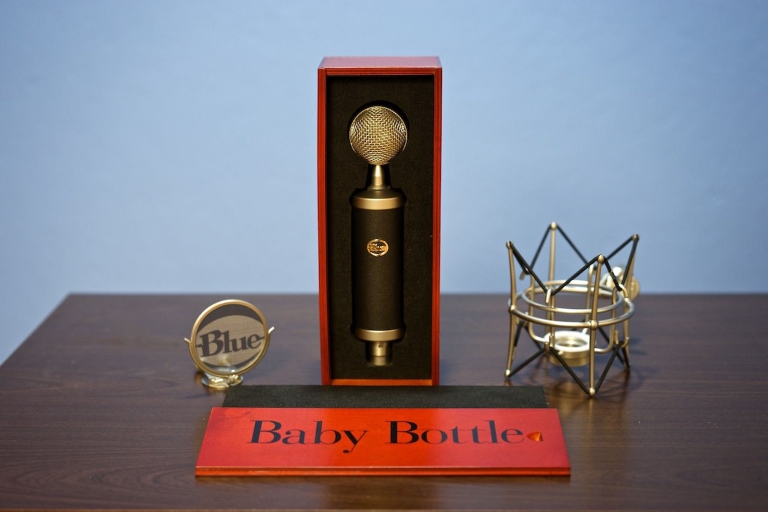
Blurb:
Blue Microphones' transformerless Baby Bottle cardioid condenser microphone delivers a rich, accurate midrange response that makes it ideal for recording vocals, drums, and electric guitars, along with more difficult sources like saxophones and horns. It utilizes Blue's famous hand-tuned and tested large-diaphragm capsule and a Class-A discrete circuit to achieve superior detail and clarity. And its unique, vintage-inspired appearance adds a little something extra to your studio presence. The complete Baby Bottle package includes a pop filter, custom spider shockmount, and wooden storage case.Vintage Design, Professional Results
Reminiscent of some of the world's finest vintage microphones, the Baby Bottle microphone can cut through the busiest tracks, while maintaining the high-quality, no-compromise audio that you expect from Blue Microphones. The Baby Bottle was designed shortly after Blue's famous Bottle microphone, and--like its predecessor--features a seamless blend of style and sound quality. This starts with a lollipop spherical grille housing Blue's renowned hand-tuned and tested large diaphragm capsule, and extends to include a transformerless output design that delivers accurate sound-source reproduction.
A Distinctive Sonic Signature
Each professional-grade Blue microphone utilizes a unique, proprietary capsule design to capture a specific sonic signature, and the Baby Bottle is no exception--it offers a full midrange response, along with a smooth top-end and neutral bottom-end, which creates an extremely rich, classic yet contemporary sound. This makes the Baby Bottle an ideal choice when you're recording vocals or room mixing for drums or electric guitar amps. It can even handle difficult sources like strings, flutes, saxophones, and brass instruments. In addition, with a unique proprietary circuit polarizing the capsule film at 100 volts, the Baby Bottle yields a large output that makes it the quietest microphone in its class.
Cardioid Polar Pattern and Discrete Electronic Components
Featuring a cardioid polar pattern, the Baby Bottle is built to capture rich, full-bodied sound from sources that are directly in front of the mic. The capsule and cardioid pattern combine with high-quality electronic components, including a Class-A discrete amplifier circuit, to ensure that each Baby Bottle mic offers consistent, reliable performance. The electronic components in Blue Microphones have been carefully selected, based on 20 years of engineering and experimentation, in order to increase microphone speed, decrease distortion, reduce product variance, and ensure long-term dependability.
Includes Shock Mount, Storage Case
In addition to the mic itself, the Baby Bottle setup includes a custom spider shock mount for controlled use and a pop filter for laying down clean vocals. It also comes with a wooden storage case that matches the mics retro good looks.
The Baby Bottle is backed by a three-year limited warranty.
What's in the Box
Baby Bottle cardioid condenser microphone, shock mount, pop filter, and wooden case.
Vocals:
Here's a little-known secret - vocalists LOVE singing into unique and impressive microphones like the Baby Bottle! Put it in front of any singer and you're guaranteed to get an inspirational performance!
Electric Guitar:
Because of its full midrange response, the Baby Bottle is an excellent mic for any clean or distorted amp sound. Orient the capsule toward the center of the speaker to capture more highs, or toward the edge of the cone for a fuller sound with more low end.
Acoustic Guitar:
Large Diaphragm mics require careful placement when used on acoustic guitar, but the Baby Bottle's rich tone and hot output is well-suited to this job.
Strings:
Because of its high output, natural highs and abundant midrange characteristics, the Baby Bottle is an excellent choice for miking all members of the bowed string family.
Drums:
The Baby Bottle's slim profile and fast transient response offer numerous advantages when recording drums.
Saxophones, Flutes & Reeds:
The smooth, natural high-end response of the Baby Bottle makes it an ideal choice for miking saxophones and other wind instruments.
Reliability & Durability :
I've owened several microphones over the years, and this one seems to be built as well as any of the others.Customer Support :
Haven't had any reason to call them.Liked about it :
For a while, I was recording using a Shure SM58, which is touted as the standard. When doing some tests, I found the SM58 to sound a little tinny, and definitely not warm. I recorded some test tracks with an acoustic guitar, located around the 12th fret, angled toward the body. The sound still wasn't warm. I was pretty stunned, since I used that mic for backup vocals for many years.I heard some great things about Blue microphones, so I stanted looking into them, and they were getting rave reviews. The mic was still a higher in price than I was considering spending, and that's when lightning struck. Right around that time, Blue was having an incredible sale. This made me reconsider buying a Blue microphone and started me thinking which one I would be buying. After reading tons of reviews, and watching tons of videos, the Baby Bottle was my choice.
One of my first tests was some simple vocal tests. Considering my voice being horrible, the sound was nice and warm, and definitely not muddy.
Next was some tests recording an acoustic guitar. I placed the mic exactly where I placed the SM58 before, and hit record. The difference was stunning. The Baby Bottle had a wonderful warm tone, unlike the SM58. It also caught the highs correctly, not "tinny" at all. I'm sold on it. Didn't like : My one "gripe", if you can call it that, only cosmetic, is that the pop screen has the word blue on it. This isn't a bad thing, it actually looks pretty nice. The problem is that I have the mic on a boom stand, and the microphone is upside down on the boom stand. This means the word "Blue" is also upside down. If the screen portion was removable from the pop screen mount, I'd be able to turn it so that print would be facing in the correct direction. This gripe has absolutely nothing to do with the microphone's functionality. Strickly a cosmetic thing.
Rating: 8/10
From the first time I plugged the mic in, I found it to be far warmer to the industry standard Shure SM58. A nicer sound. The mic picks up all the nuances in the acoustic guitar, and seemed to have a larger range. Might not be a perfect representation, but definitely a good mic to record with.Focusrite Scarlett 18i20 (9/10)
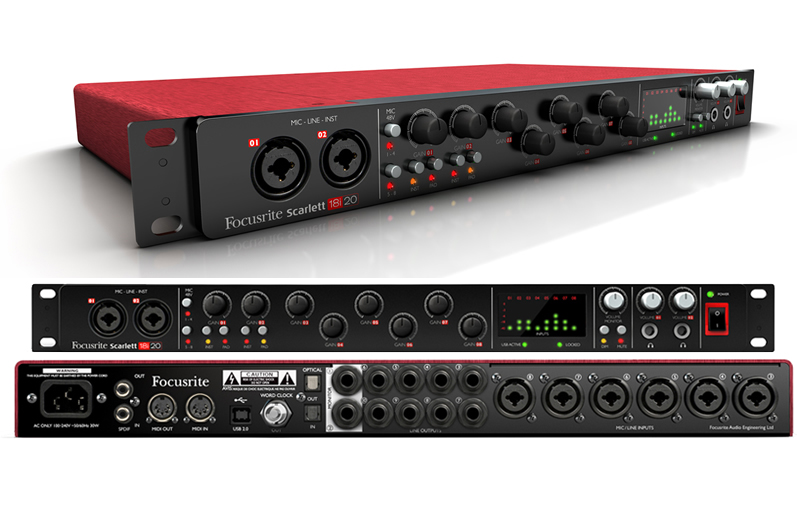
Blurb:
When I started looking for an audio interface into my PC, 2 names kept coming up: Presonus and Focusrite. I originally bought a Presonus Audiobox 1818vsl. The unit was well built, and I was excited to get to PC recording. Immediately, I found myself fighting with the drivers to get any kind of workable latency. No matter what I tried, I could not get it working. Things got so frustrating, that I did something I almost never do. I called Presonus customer service. After being on the phone with their customer service for hours, I finally said "Thank you, forget it. I'm going another route."That's when I returned the Presonus, and bought the Focusrite 18i8. After the Presonus nightmare, I didn't have much faith in it, but gave it a try. I installed the latest drivers, plugged the unit in, and it immediately worked. No noticeable latency!!!! It was perfect. After tweaking the ASIO drivers, I was able to get the latency down to around 2ms. 1 millisecond is 1000th of a second. If you think you can hear 2ms latency, you are wrong. It's basically 0ms from your ear standpoint.
Handle Anything That Comes Your Way
Our 18-in, 20-out USB audio interface can handle just about anything your band or studio can throw at it. Beautiful and rack mountable, it gives you loads of I/O, pristine sound quality, separate stereo headphone mixes, extensive expansion options and round-trip latency as low as 2.74ms*, all in a 1U space.
Scarlett 18i20 puts eight natural-sounding combination inputs at your disposal. We put two on the front, where you need them most, with newly designed instrument inputs that can handle even the hottest signals. We put six more on the back, so you can leave your mics, synths, keyboards, mixers and effects processors permanently plugged in and ready to go.
World Famous Preamps
All eight analogue inputs feature pristine and natural sounding Scarlett preamps, backed by 30 years of design experience and found in the world's top studios. These guarantee exceptional headroom, plenty of clean gain, low noise, minimal distortion and a dynamic range that is unrivalled in this class.
Create Separate Monitor Mixes
As well as eight balanced analogue line outputs, Scarlett 18i20 gives you two independent stereo headphone outputs so you can give engineer and artist their own separate, fully-customised mixes.
Revolutionise Your Workflow
An unrivalled round-trip latency as low as 2.74ms* completely revolutionises your workflow. You can work entirely inside your DAW for both overdubbing and playback, and use your plugins while recording - depending on your software, settings and computer, of ourse. You'll also get the best out of vocal performances, by applying real-time comfort reverb to artists' headphones.
Designed for Guitarists
We've redesigned Scarlett 18i20's instrument inputs and given them plenty of extra headroom, so you can handle extreme levels without any unwanted clipping or distortion. If you're recording extra loud instruments, you can also engage the 10dB pad in Focusrite Control software.
Microphone Inputs
Frequency Response : 20 Hz - 20 kHz +0.5/-1.5 dB
Dynamic Range : 109 dB (A-Weighted)
THD+N : <0.002%
Noise EIN : -127 dBu
Maximum input level : +8.5 dBu
Gain Range : 50 dB
Impedance : 3k Ω
Line Inputs
Frequency Response : 20 Hz - 20 kHz +0.5/-1.5 dB
Dynamic Range : 109 dB (A-Weighted)
THD+N : <0.003%
Maximum input level : +22 dBu
Gain Range : 50 dB
Impedance : 52k Ω
Instrument Inputs
Frequency Response : 20 Hz - 20 kHz +0.5/-1.5 dB
Dynamic Range : 109 dB (A-Weighted)
THD+N : <0.003%
Maximum input level : +12 dBu
Gain Range : 50 dB
Impedance : 1M Ω
Monitor Outputs (1-2)
Frequency Response : 20 Hz - 20 kHz ±0.5 dB
Dynamic Range (Line Outputs) : 108 dB (A-Weighted)
THD+N : <0.001%
Maximum Output Level (0 dBFS) : +16 dBu
Impedance : 94 Ω (Balanced)
Line Outputs (3-10)
Frequency Response : 20 Hz - 20 kHz ±0.5 dB
Dynamic Range (Line Outputs) : 108 dB (A-Weighted)
THD+N : <0.001%
Maximum Output Level (0 dBFS) : +16 dBu
Impedance : 94 Ω (Balanced)
Headphone Outputs
Frequency Response : 20 Hz - 20 kHz ±0.5 dB
Dynamic Range : 108 dB (A-Weighted)
THD+N : <0.001%
Maximum Output Level : +13 dBu
Impedance : 10 Ω
Reliability & Durability :
I have been owned 2 Focusrite Scarlett units, and the only reason that I owned 2, was because I upgraded from an 18i6 to an 18i20. The original unit worked perfectly the day I bought it, and the day I sold it.Customer Support :
Haven't had any reason to call them.Liked about it :
After plugging the unit in and working in 2ms latency, I was thrilled. That alone would be enough to justify the price of the unit. But it has multiple inputs with excellent converters. Absolutely loved everything about it. But there was more. It comes with a software mixer, Scarlett MixControl, which is a fully functional mixer.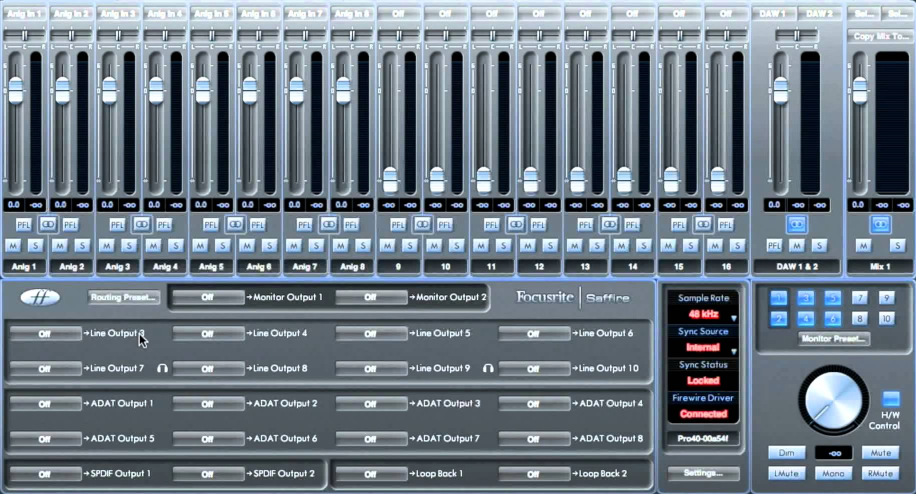
With the MixControl software, you can do pretty much anything you can do on a real mixer. You can route inputs/outputs to different locations. For example: If you have a band, and start a recording, you can record everyone at the same time. With the routing option, the singer might only want to hear the drums and bass. The guitar player might not want to hear the singer, the bass player might only want to hear the drums. All of this is possible through routing...and all at the same time!!!
If that wasn't enough, the unit comes Didn't like : The only problem I have ever had with any focusrite happened years ago, and was quickly fixed. The headphones would cut out during peak PC usage. The only way to get the sound back was to reboot the unit. The issue was a DRIVER ISSUE, which was fixed in the next driver release.
Rating: 9/10
From the moment I plugged the unit in, I loved it. The Scarlett MixControl software adds a whole new dimension to the unit. The 18i20 not only gives me everything I could want now, but gives me all the inputs I could ever need going forward.Effects / Accessories
Peterson StroboPlus HD Tuner (3/10)
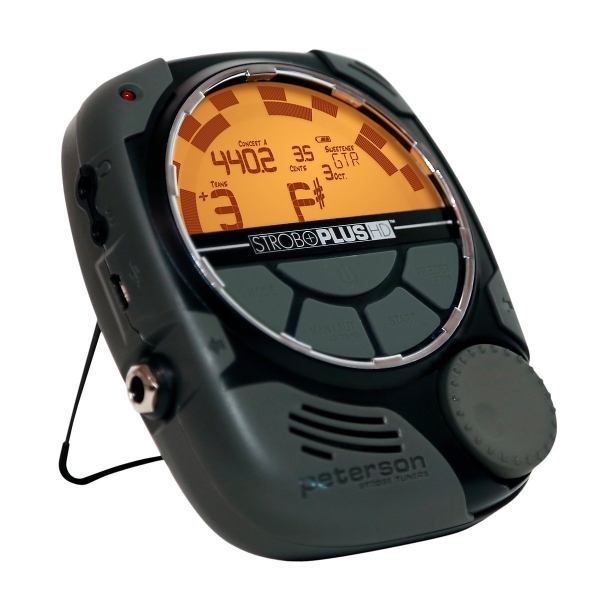
Blurb:
Really Peterson? The StroboPlus HD? Really?????I lost my strobe tuner when Hurricane Sandy created a tidal wave that basically flooded the North-East corridor of the U.S. So after trying to do setups on a couple of new guitars, I knew that I needed another strobe tuner. There is nothing like a Peterson. Very reliable, and usually make like a tank. I said usually. I ordered the StroboPlus HD from Guitar Center, and it arrived quickly. I was thrilled.....for about 10 seconds. When I held it in my hands, and realized how crappy it was, I couldn't believe it. It wasn't made like the previous models. This thing felt like a cheap toy. It was plastic. They added a single plastic wheel on the front to dial through the options. There are several sweetened tunings available, and these are slight variations on the hard standard tunings. To be honest, I really didn't hear a difference in the Sweetened Guitar tuning vs standard. But that could just be me. Peterson releases updates for the unit periodically, and you simply plug in the device, and run their software, and it will update the unit with the latest firmware. Most of the updates are tweaks to the sweetened tuning options. It has a large amber display that it easy to read. I didn't try it in sunlight, but I doubt it would hinder the visibility.
Reliability & Durability :
I was afraid that it would break quicker than my smartphone if I dropped it. It seemed very cheaply made.Customer Support :
Customer support seems to be pretty good. In my case, I'm not talking about calling them with any issues. I'm talking about the multiple updates that have been given for both units.Liked about it :
The standard Peterson strobe tuning that we've become accustomed to over the years. Frequent firmware updates.I also HATED the fact that I spent a ton of money on a toy, and was told that I had to play $49 more to activate the metronome functionality in the unit. What is this? Shareware? I can buy a phone app for $.99 that will do the same thing. Are they kidding?
Rating:
3/10 and it ONLY got 3 stars because it's a Peterson. The tunings work as they should. But the overall quality of the unit is crap. Thankfully, I was able to return it and grab a VSS-C Stomp classic pedal tuner. I'll post that review soon.Peterson VSS-C Stomp Classic Strobotuner Pedal Tuner (10/10)
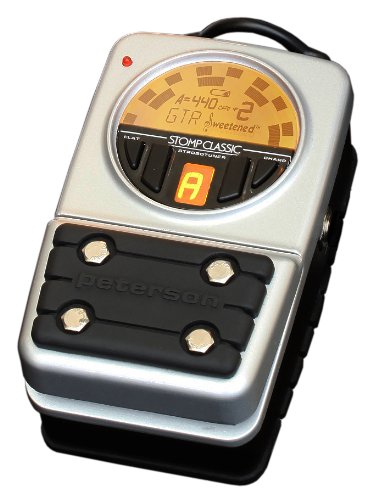
Blurb:
I lost my strobe tuner when Hurricane Sandy created a tidal wave that basically flooded the North-East corridor of the U.S. So after trying to do setups on a couple of new guitars, I knew that I needed another strobe tuner. There is nothing like a Peterson. Very reliable. I got this tuner after the misfortune of buying the StroboPlus HD first. So, there will be some comparisons to that unit in this review. ( see StroboPlus HD ) This thing is built like a brick s-house, unlike the StroboPlus HD. It actually weighs about as much as a standard brick. It is a very solid pedal. I has a thick rubber bottom on it for using it on a table or desk. It also has 2 options for being placed on your pedalboard. The unit comes with 4 metal feet that allow you to screw that pedal into your board. If you're not that extreme, like me, there is also an option to remove the rubber bottom easily by removing the 4 screws that keep it in place. Then you do what you do with all you other pedals, throw some industrial strength Velcro on the back and place it on your board. The unit has "Sweetened Tunings" for various instruments and tunings. Apparently, they are supposed to make the instrument sound "sweeter", but my ears couldn't notice a difference. But I do keep the unit on the "Sweetened Guitar" setting, I could use the help :) The unit has a micro usb jack, where you can connect it to your computer and run their software for pretty frequent firmware updates. That's a nice feature. I guess it's a great business move. Even if they just update the version number, it makes you feel good that they are doing something for you :)Reliability & Durability :
Did I mention that this thing is a tank. As long as another tidal surge doesn't wipe it out, I think it will be the last tuner I will ever have to buy.Customer Support :
Customer support seems to be pretty good. In my case, I'm not talking about calling them with any issues. I'm talking about the multiple firmware updates.Liked about it :
The standard Peterson strobe tuning that we've become accustomed to over the years. Frequent firmware updates.Didn't like : I can honestly say that I haven't run into any negatives yet with this unit. It does everything that we've come to expect from Peterson tuners.
Rating:
10/10 - This thing is everything the StroboPlus HD was not.Digitech Drop (10/10)

Blurb:
An incredibly simple and useful pedal that should be the first pedal on your pedalboard, right behind your tuner. Simply choose how many semitones you want to drop your existing guitar signal. Works for everything from a half step to an octave drop. There is a switch for always on or only on when the footswitch is pushed (momentary). I have never used the momentary switch, other than to test it. The Digitech Drop is great for floating bridge guitars, that would take a while to set in a lower tuning. Just leave your guitar at its current tuning, and click the Drop pedal, and the signal changes to the dropped signal Have a singer that sings in Eb, but your guitars are tuned to E? Just click the Digitech Drop with the knob on 1 semitone drop, and you are ready to go. Have a guitar set to Drop D tuning, and set the Digitech Drop to 2 semitones, and your guitar is now in Drop C, without the need to use higher gauge strings.Reliability & Durability :
Built like a tank, that will hold up to the test of daily use.Customer Support :
Haven't needed them. The pedal works perfectly.Liked about it :
This pedal is a MUST HAVE for anyone who wants to keep their guitars in a certain tuning, or has floating bridge guitars.Didn't like : I can honestly say that I haven't run into any negatives yet with this unit. It does everything that we've come to expect from Peterson tuners.
Rating:
10/10 - A MUST HAVE pedal. It will be a constant in my pedalbaord for years to come.Digitech FreqOut (7/10)
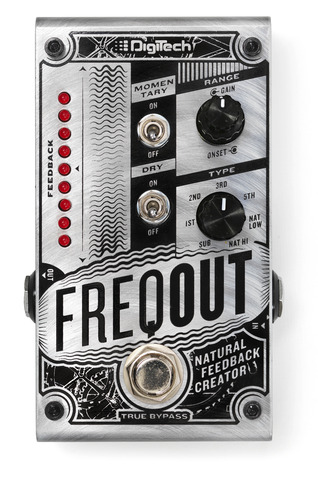
Blurb:
The DigiTech FreqOut Natural Feedback Creator allows you to get sweet, natural feedback at any volume, with or without distortion. The FreqOut is perfect for situations where volume must be controlled like in the studio, with in ear monitors, or low-volume performance and practice. However, the FreqOut can also be used at gig volume to focus out-of-control feedback on a preferred harmonic at any stage position.The FreqOut has adjustable feedback Onset (delay before feedback begins), Gain (feedback level to balance with your dry signal), Dry On/Off, latching or momentary operation, true bypass, and a rugged road-tough steel chassis.
Reliability & Durability :
Like most pedals, this one is built like a tank.Customer Support :
No need to call customer service. The pedal works perfectly.Liked about it :
Get that feedback tone at low volumes, anywhere, anytime. Didn't like : A little learning curve to get the settings the way you like. But once you get the hang of it, it's a great pedal.Rating:
7/10 - A great pedal to get feedback at low volumes.Friedman BE-OD (9/10)
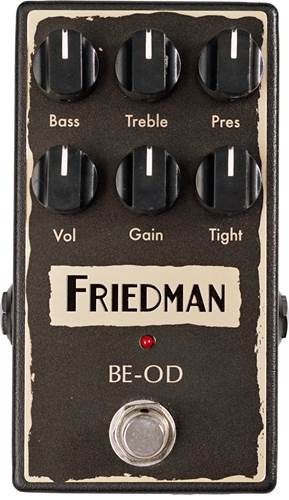
Blurb:
The BE-OD overdrive pedal captures the tone of the now legendary Friedman BE-100 amplifier which has graced the stages of world-class musicians the world over. The BE-OD delivers authentic tube-amplifier sound from a compact pedal with the controls needed to shape your tone including volume, gain, tight, bass, treble and presence. These responsive knobs will take you from light, slightly broken up overdrives to straight up gain nirvana. Built in the USA and designed to withstand decades of abuse the BE-OD is a must have pedal for any tone enthusiast. There is an internal pot that allows you to set the range of the gain this pedal delivers.Reliability & Durability :
Like most pedals, this pedal can withstand the test of years of use on your pedalboard.Customer Support :
No need for Customer Support.Liked about it :
This pedal gives you the sound of the legendary BE-100 amplifier in a pedal. I tested this pedal, using the train of The guitar into the BE-OD pedal, into a PowerStage 170, into a cabinet, and it sounded fantastic. Just a great pedal.Didn't like : I can honestly say that I haven't run into any negatives yet with this pedal.
Rating:
9/10 - A great overdrive pedal, that sounds like a classic amplifier.Golden Horse (Klon Clone) (8/10)
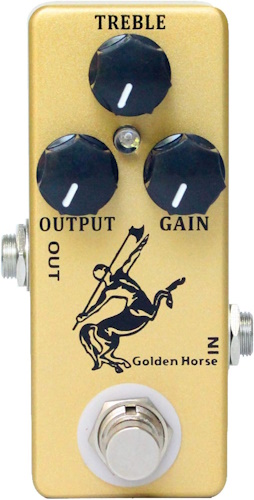
Blurb:
This is a very inexpensive Klon clone pedal. The sound is actually impressive considering its price point. Josh from JHS Pedals did a blind comparison between the real Klon and this pedal. Amazingly the testers picked the $30 pedal over the $3000 pedal.Reliability & Durability :
Like most other effect pedals, this is well made and should work for years on any pedalboard.Customer Support :
No need for support.Liked about it :
This pedal surprised me at the sounds you can get out of it. It does "the Klon thing" very well.Didn't like :
If I had to pick a negative, like all other micro pedals, there is no room for a battery. The only way you could use a battery is to buy an adapter that had a 9V connection on one end, and a pedal connection on the other end. They sell them, but you're better off getting a pedal power brick.Rating:
Being an incredibly cheap pedal, and doing what it does (the klon thing) very well, it deserves at least an 8 out of 10. Probably higher.JHS Bonsai 9-way Screamer-style Overdrive Pedal (9/10)
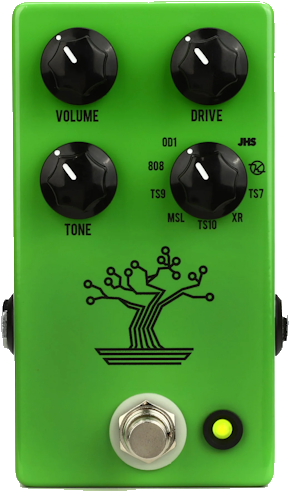
Blurb:
The Bonsai gives you access to four decades' worth of Tube Screamer pedals. There are nine different sonic textures to choose from. Want some classic mid-bump grind? It's in there. SRV-style dirty boost? Yep. Mayer-esque low-gain grit? You got it — and a whole lot more. The Bonsai isn't a modeler — it boasts the exact same components as the source units. So when you select a mode with the Bonsai's rotary control, your guitar signal actually passes through a replica of the original pedal's circuitry. With the Bonsai, you truly get nine overdrive pedals packed into one housing.- OD1 (1977) A brighter and somewhat higher gain mode that doesn't utilize the Tone knob
- TS808 (1979) The classic low-gain grind with the signature mid-bump
- TS9 (1982) Similar to the TS808, but with a brighter, SRV-style sound
- MSL (1985) The "metal" version produces a higher-gain sound with more low end
- TS10 (1986) Replicates the bluesy low-gain sound popularized by John Mayer
- XR (1989) Duplicates the Polish-made EXAR OD1, known for its unique drive character and slightly higher gain
- TS7 (1999) The late-'90s overdrive with a "hot mode" that yields more gain and low-end dirt
- Keeley (2002) Robert Keeley's classic Mod+ that tightens up your tone and gives you less noise, along with smoother mids and highs and increased bass
- JHS (2008) JHS's "Strong Mod" that gives you a cleaner sound with a serious power boost
Sound:
This pedal gives you all the classic Overdrives/Tube Screamers in one pedal. This is not a modeling pedal, it replicates the circuitry of the original pedals.Liked about it :
All your favorite Overdrives/Tube Screamers in one pedal.Didn't like :
If there had to be a gripe, I would say that midi controllable settings would make this pedal a solid 10/10. But since it's an analog pedal, it's not feasible.Rating:
A solid 9/10.Catalinbread Sabbra Cadabra Overdrive Pedal (8/10)
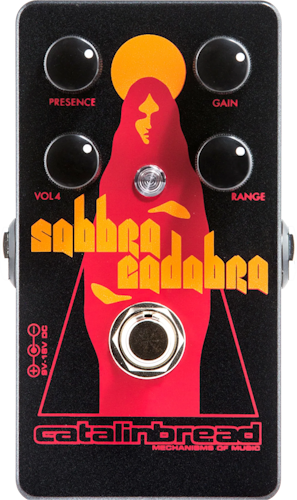
Blurb:
This pedal is Tony Iommi in a box. It's a Rangemaster-based treble booster that's custom-tuned and paired with a Laney Supergroup's preamp section. The offspring of this union is as gnarly in pedal form as it was as the foundation of Tony Iommi's original setup. The design of the Sabbra Cadabra will take your tone to the dark side all on its own, but you get Presence, Gain, Volume 4 (named after the album), and Range controls for fine-tuning and shaping your sound further.Sound:
You can very easily dial in Tony Iommi's classic sounds with this pedal.Liked about it :
It's Tony Iommi in a box. Play all your favorite Black Sabbath tunes with Tony's sound.Didn't like :
Being that I'm not a big fan of fuzz sounds, this can get into the fuzz world fairly quickly. But that's what Tony had on some songs, so it should be there.Rating:
8 out of 10. Kick on the pedal, and you sound like Tony Iommi. A must have to Iommi fans.Catalinbread Skewer Boost Pedal (8/10)
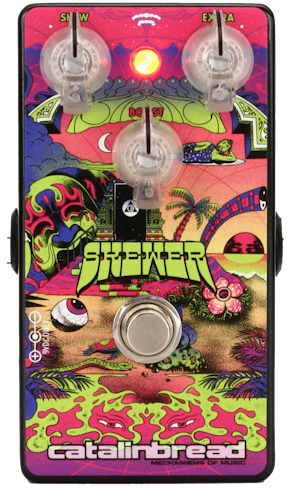
Blurb:
The treble-heavy tone the infamous Hornby-Skewes booster is yours for the taking with the Skewer Boost Pedal from Catalinbread. The Hornby-Skewes Treble Boosterwas the boost pedal used throughout the late '60s and early '70s, which gave dozens of artists a tone with a treble-rich sonic edge. The Skewer from Catalinbread features a true-to-original circuit with a silicon transistor that ups the bite in your tone, putting your leads front and center in any mix. Much like Catalinbread's Naga Viper, the Skewer Boost can dial in everything from rich, warm midrange to full-on treble cascade, all while letting you control the amount of boost you desire.Sound:
A very versatile treble booster pedal, with the option to add in as much mid and lower end as you wish. When completely open, it's basically a clean boost that has the option of adding more gain via the gain knob.Liked about it :
This pedal can be a clean boost, treble boost, and a gain pedal, depending on the knob settings. A very versatile pedal.Didn't like :
Not much not to like. If it doesn't sound good to you, change the settings.Rating:
8/10. A solid treble booster.Catalinbread Dreamcoat Preamp Pedal (1/10)

Blurb:
Ritchie Blackmore used an Aiwa TP-1011 reel to reel as a preamp into his amp. The Dreamcoat lets you tap into the tone of the Aiwa TP-1011 reel-to-reel deck. It features an active, adjustable frequency boost coupled with a vintage-correct Aiwa circuit and a clean blend, translating to an array of tones that range from singing and clear to howling and crunchy. Plus, a saturation control for the Aiwa pre takes your tone from crystal-clear highs to doomy sludge and all points in between. Guitarists here at Sweetwater are incredibly impressed with the true-to-the-era tones the Dreamcoat delivers, as well as the plethora of overall classic rock tones and textures this pedal provides!Sound:
This pedal is supposed to give you the Aiwa TP-1011 sound, I had a problem getting a decent sound out of it.Liked about it :
Not much. This pedal goes from clean to fuzz in the slightest turn of a knob.Didn't like :
I bought this as part of the Ritchie Blackmore set that Catalinbread was selling. I was excited to try it out, so I grabbed my Ritchie Blackmore strat. Upon trying it, I soon realized that this wasn't what I was hoping for. IMHO, this pedal is not an Aiwa pedal, it's an over the top fuzz pedal. I could not get a Ritchie Blackmore sound out of this thing, no matter how hard I tried. I tried on several amps, Vox amp, clean amps, Marshalls, etc., and ended up frustrated. I then went online to see some people's demos of the pedal. Not one of them successfully reproduced Ritchie's sound. They tried to act like they did, but to my ears, they weren't close. I kept coming back to the pedal, after reading people's responses, and nothing that I tried got me anywhere near Ritchie's tone. Months went by, and I would take it off my board, then decide to give it another shot. Sadly, the same result. I even tried to contact Catalinbread, via their Facebook page, and never got a response. Eventually, I got tired of trying, and sold the pedal. If someone wants an over the top fuzz sound, this is the pedal for you. If you're looking for that Ritchie Blackmore sound, look at the BSM pedals.Rating:
1 out of 10. I couldn't get the pedal to get me even close to Ritchie's sound. In fact, I got closer with only the Skewer than I did with either only the Dreamcoat, or the Skewer pushing the Dreamcoat. Hands down, the worst pedal I have ever owned.BSM HS-S Master Treble Booster (7/10)
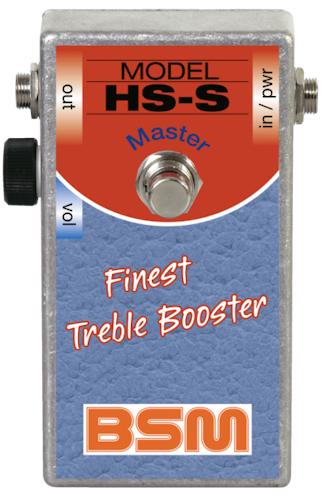
Blurb:
As a follow-up of the short-lived germanium-transistor loaded early issued Hornby-Skewes Treble Booster, now the 1967 version, equipped with a silicon transistor, appears on the scene under the BSM brand HS-S. With additional volume control like Blackmore´s modified unit as HS-S Master available. The Hornby-Skewes Treble Booster was Ritchies favorite box for live and studio recordings like the famous 1971 "Machine Head" or the later 1974 "Burn" session. The HS-S Master in front of a Vox AC30 gives you the unique sound of the well-known rock hymn "Smoke on the water". Compared to its forerunner, the HS-S sounds a tad more aggressive with more mid-range with the guitar's volume pot fully opened, a little bit similar to a WahWah sound. But the higher the pre-amp volume of the amp is dialed in, the more this midrangy tone will be forced into the background because now the saturation of the amp will generate the necessary harmonics. So it's up to you to chase the sweet spot of the HS-S unit. You will have to raise the pre-amp volume of a Marshall Major noticeably because this amp is a very clean sounding one. To have some good reserves when dialing in the pre-amp volume Blackmore had his Major amps modded early with a cascaded pre-amp design right from the factory.Sound:
This pedal gets you close to Ritchie Blackmore's sound on the classic Machine Head and Burn albums.Liked about it :
A great treble booster, the master volume knob lets you set how much you want to push your amplifier.Didn't like :
The master volume knob is on the side of the pedal. Maybe if it was on top, it would be easier to access, especially on a pedalboard.Rating:
7 out of 10.BSM RPA Major Special Booster (10/10)
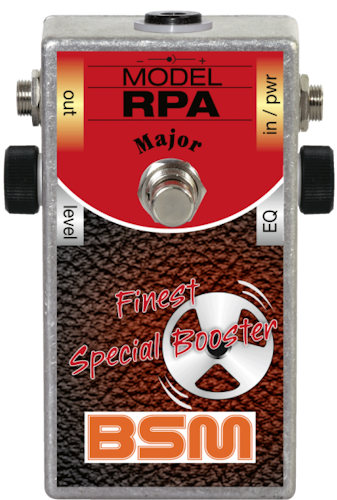
Blurb:
The RPA Major for the hard, agressive Ritchie Blackmore stage sound of the 70's, without the need to get their amp heavily modified. The RPA Major offers a lot more gain compared to the stock RPA model with tons of crunch and a higher level of agressivity ... something that fits the modern Metal scene as well. With the level control turned up to the max, the RPA Major delivers an output level of 8 volts (!!!), which can kill most modulation stompboxes with electronical CMOS switching like delay, chorus etc. that are connected after the RPA Major in the signal chain. So please only use the RPA Major with full level directly into your tube amp. If you want to connect some stompboxes after the RPA Major, reduce the level to 50% to be on the safe side.Sound:
This pedal is Ritchie Blackmore's 70s sound in a box.Liked about it :
After fighting with the Dreamcoat pedal to get a good Ritchie tone, I was very optimistic about this pedal. All that changed when I plugged this pedal into my pedalboard (last of course). Hitting the first chord and I had a smile. This is the Ritchie Blackmore sound that I have been searching for.Didn't like :
There is nothing I don't like about this pedal. I guess you could gripe about BSM pedals being too expensive, but the results are there.Rating:
10/10 Ritchie in a box. Worth every penny.ISP Technologies Decimator II G String Noise Suppressor (10/10)
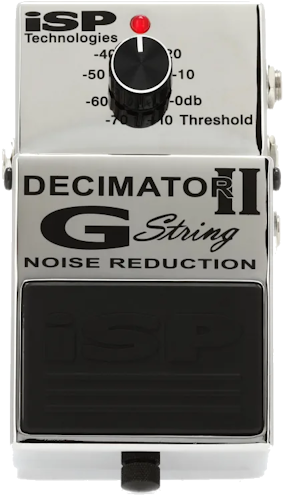
Blurb:
ISP's Decimator II G String noise reduction pedal tracks the signal directly from your guitar, which lets you go from clean to high gain without changing the threshold. This improved design lets you connect the processing channel into your effects loop after your high-gain pedals or preamp. An 1/8" phone cord engages the linking function, letting you link two Decimators for two channels of noise reduction (or a cool stereo setup). ISP Decimator II G String Noise Reduction Pedal Features at a Glance: Tracks the signal directly from your guitar Go from clean to high gain without changing the threshold setting Linking function lets you link 2 Decimators for 2 channels of noise reduction You can use 1 Decimator G String II and 1 Decimator II pedal for a stereo setup Offers the same tracking performance of ISP's professional ProRack G systemSound:
If you're playing high gain sound, you know the noise that comes along with it. In this case, no sound is what you're looking for. The G String has one knob, the threshold that lets you set the amount of noise suppression you're looking for.Liked about it :
This noise Suppressor was the best I have ever used. Head and shoulders above the rest. The 4 cable method, where it connects to guitar into the amp and also through the effects loop, gives you the best noise suppression around.Didn't like :
For amps that may not have an effects loop, you need to connect a jumper cable from the Guitar In to the Dec In connections for the pedal to work. It won't work otherwise. You won't get a signal. But this is such a minor thing, considering how well it works.Rating:
DigiTech CF-7 Chorus Factory (7/10)
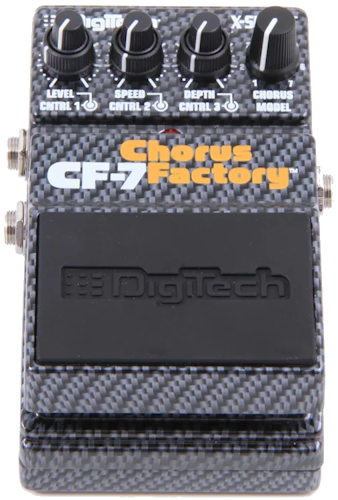
Blurb:
All your favorite chorus pedals in one rugged unit. The DigiTech CF-7 Guitar Effects Pedal features models based on both classic and the latest modern chorus pedals including the- DigiTech Multi Chorus
- Voodoo Lab Analog Chorus
- TC Electronic Stereo Chorus/Flanger
- Fulltone Choralflange
- Boss CH-1 Super Chorus
- EH Small Clone
- Boss CE-5 Chorus Ensemble
Sound:
All your favorite chorus pedals in one unit.Liked about it :
Option to use the special features of any of the 7 pedals in this unit.Didn't like :
Some pedal options change the controls to different values. A little confusing at first, until you get used to the pedal.Rating:
7 out of 10.BOSS DD-7 Digital Delay (7/10)
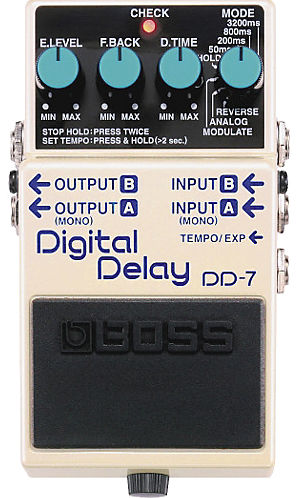
Blurb:
A high quality delay box for a decent price. It set the standard for many pedals that followed it and it is easy to see why. There are a few different delay types and a healthy amount of potential delay time. This is a pedal that will not break the bank and will definitely do the job. This is an easy pedal to use. It can be initially difficult to figure out the various time-based delay settings and how they work, but that problem does not last long. You may have some serious frustration with the built in tap feature, but that can be alleviated with the addition of an external tap. All of the delay types are good quality, and your tone will be nicely reproduced. Built like a tank, this pedal has lasted many years on many boards. It is truly a workhorse, especially for someone not looking to overcomplicate their setup with an insanely intricate delay pedal.Sound:
A delay pedal with a number of options. A few different types of delays, and a lot of time based delays.Liked about it :
I mainly use the analog delay option, and it works very well. The tap tempo is a little quirky, but works.Didn't like :
The lack of different types of delays, in lieu of time delays is a little puzzling.Rating:
7/10 due the lack of different delay options.Hotone Binary IR Cab Simulator Pedal (6/10)

Blurb:
This is basically an Impulse Response loader with many options. The Hotone Binary IR cab simulator takes the realistic sound of premium impulse-response speaker emulation and packs it into a compact, pedalboard-friendly format. Loaded with 100 classic cabinet models, Binary IR also boasts 11 studio microphone simulations and eight power amp simulations — you can even manipulate the virtual microphone placement with the X, Y, and Z knobs. Combined with an amplifier simulator (like the Hotone Binary Amp pedal), it's a great way to hit the stage without a traditional amplifier and cabinet setup. Best of all, the Hotone Binary IR pedal works with third-party impulse responses, so you can easily upload your favorite cab sims via USB.Sound:
Depending on the IR used, the sound can be very good.Liked about it :
The software is easy to use, and the ability to load 3rd party Impulse ResponsesDidn't like :
Some of the IRs seem to become dull when played through the CAB, compared to an IR loader in your DAW.Rating:
6/10. A good entry level IR loader, exceptional for the price.Wampler dB+ V2 Buffer / Clean Boost Pedal (10/10)
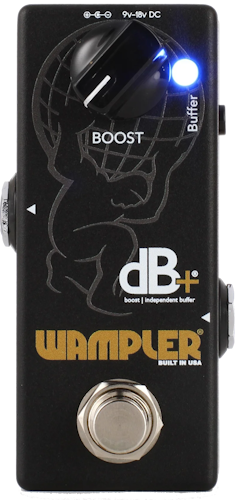
Blurb:
An 18v clean boost pedal that does exactly what it claims to do. The side button controls the buffer on/off. This is a great feature, where you can engage the buffer even when the pedal is not engaged. A great feature. The dual-purpose Wampler Pedals dB+ buffer/boost pedal is a smart addition to any electric guitar rig. Avoid the tone suck of a large pedalboard or long cable runs by using the dB+ as a buffer. Just set the gain at a unity level to your amp, and you'll buffer your entire signal chain without losing fidelity and clarity. As a boost, the Wampler Pedals dB+ is extremely musical and is great for adding punch to a solo. This true bypass pedal is perfect for sending your amp over the edge without compromising your fundamental tone.Sound:
Clean boost. Nuff said. It does what it says it does.Liked about it :
A small footprint pedal that works incredibly well. The optional buffer switch is a great feature, especially for longer cable setups.Didn't like :
Nothing not to like. It works.Rating:
10/10 - Does what it says it does, extremely well.MXR M108S Ten Band EQ Pedal (9/10)
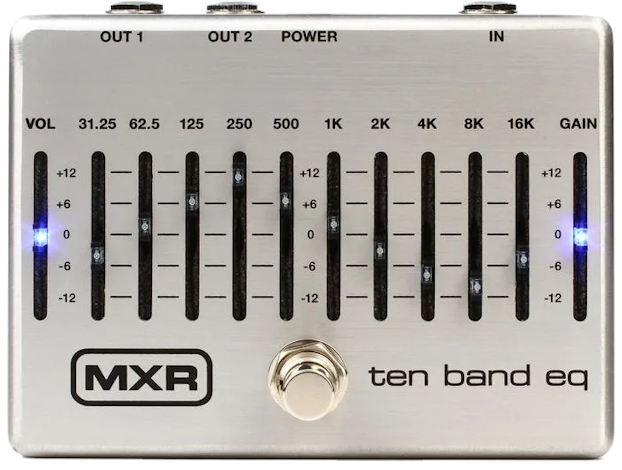
Blurb:
Use the MXR Ten Band EQ Pedal for precision control over your guitar or bass tone. Featuring 10 EQ sliders, with carefully selected frequencies and +/-12dB boost/cut range, you can optimize your sound in any room or recording session. Additional Volume and Gain sliders allow you to use the Ten Band EQ Pedal as an extremely tweakable boost pedal. Dual outputs allow you to feed two amplifiers at once. And 18-volt operation ensures you'll have all the headroom you need, even if you're running a chain of pedals into it. Built with rugged aluminum and featuring true bypass switching, the MXR Ten Band EQ Pedal is a fine addition to any pedalboard.Sound:
Not really a sound thing. More of a sound sculpting thing. The EQ can be placed in 3 places: Before the amp, to change your guitar's sound or as a boost. In the FX Loop, to change the sound of the amplifier before it goes to the speaker. In the mixer, to shape the overall sound of the mic'd sound.Liked about it :
A great 10 band EQ with level and gain sliders so you can use this as a boost pedal if you wish.Didn't like :
The lights!!! This pedal is bright AF. The level and gain sliders are always lit. I fixed this by turning the slider leds on the level and gain around, which disables them. Now at least the pedal is only lit when engaged.Rating:
9/10 - Might be a 10 if it wasn't for the ridiculously bright leds on the pedal.MXR EVH 5150 Overdrive (10/10)
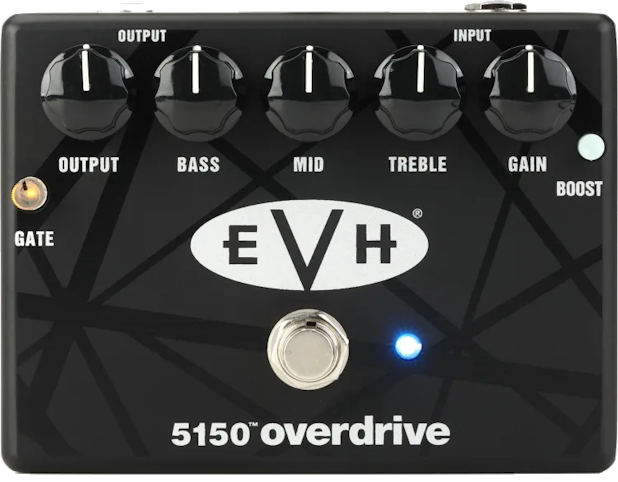
Blurb:
Designed in conjunction with Eddie Van Halen, the MXR EVH 5150 Overdrive effects pedal is a sonic replica of an EVH 5150 III's blue channel. This amp-in-a-box pedal has the high gain of the amplifier and just as much string-to-string clarity. A 3-band EQ lets you dial the pedal in to complement your rig. An onboard boost adds gain and compression for punching through the mix. And a one-knob Smart Gate function. Overdrive pedal based on the Blue channel of the EVH 5150 amplifier. 3-band EQ lets you dial in your perfect tone. Add extra punch to your sound with the +6dB Boost. Intelligent noise gate reacts slowly when you're holding sustained notes and faster when your playing speeds up. True-bypass operation keeps your tone clean when not engaged. Runs from a 9-volt battery or power supplySound:
This will give you that EVH sound. Add in the MXR 5150 Flanger to get Eddie's classic sound on the first few albums.Liked about it :
Incredibly easy to use, and dial in Eddie's classic sound. The boost is an added feature that brings the OD to the next level.Didn't like :
There isn't anything I could say I didn't like about it.Rating:
10/10 - Eddie Van Halen's classic sound in a box. It's that simple.Walrus Audio Julianna Stereo Analog Chorus/Vibrato (10/10)
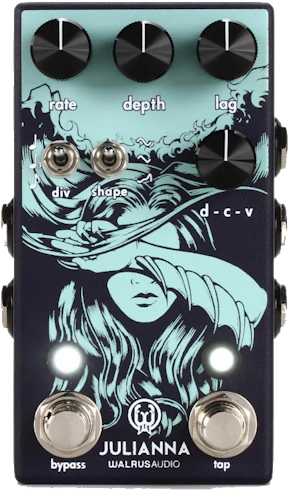
Blurb:
This is, by far, the best chorus pedal I have ever used. Walrus Audio's Juliana was an instant favorite with its rich, cascading chorusing, vibrant vibrato, and unique lag function, which can send the effect into seasick, loping ambulation. Julianna also has a handful of unique tricks. First and foremost, Julianna features stereo outputs, ideal for wet/dry/wet setups or for creating extra-wide effects in the studio. Next, Julianna treats you to a tap tempo for setting the rate of the effect and a tap division control to split the tempo into quarter notes, quarter-note triplets, or an eighth-note multiplier. Julianna's expansive LFO controls take chorusing into unexplored chasms, including a random waveform setting; a secondary LFO speed, which you can ramp up or slow down to; and a drift function for gently accelerating and decelerating the LFO rate to make Julianna's warbles even warblier! Finally, Julianna is equipped with an expression jack for controlling depth, rate, or both with an optional expression pedal.Sound:
A full featured Chorus pedal, with so many extra options than it's competitors.Liked about it :
Very versatile, and very easy to dial in your favorite chorus sounds, as well as find the chorus sounds from your favorite songs.Didn't like :
There isn't anything I dislike. This is so far beyond other chorus pedals, that it deserves the 10/10 rating.Rating:
10/10 - At current, nothing comes close to this chorus pedal.